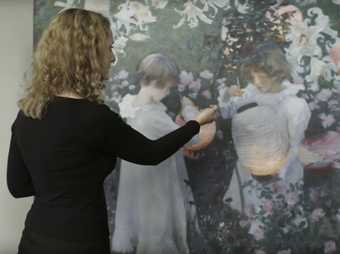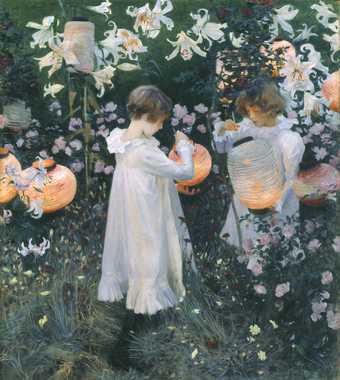
John Singer Sargent, Carnation, Lily, Lily, Rose 1885–6. Tate.
1815–1905
19 rooms in Walk Through British Art
Economic prosperity in Victorian Britain helps art become hugely popular. However, art only indirectly reflects the lives of ordinary people
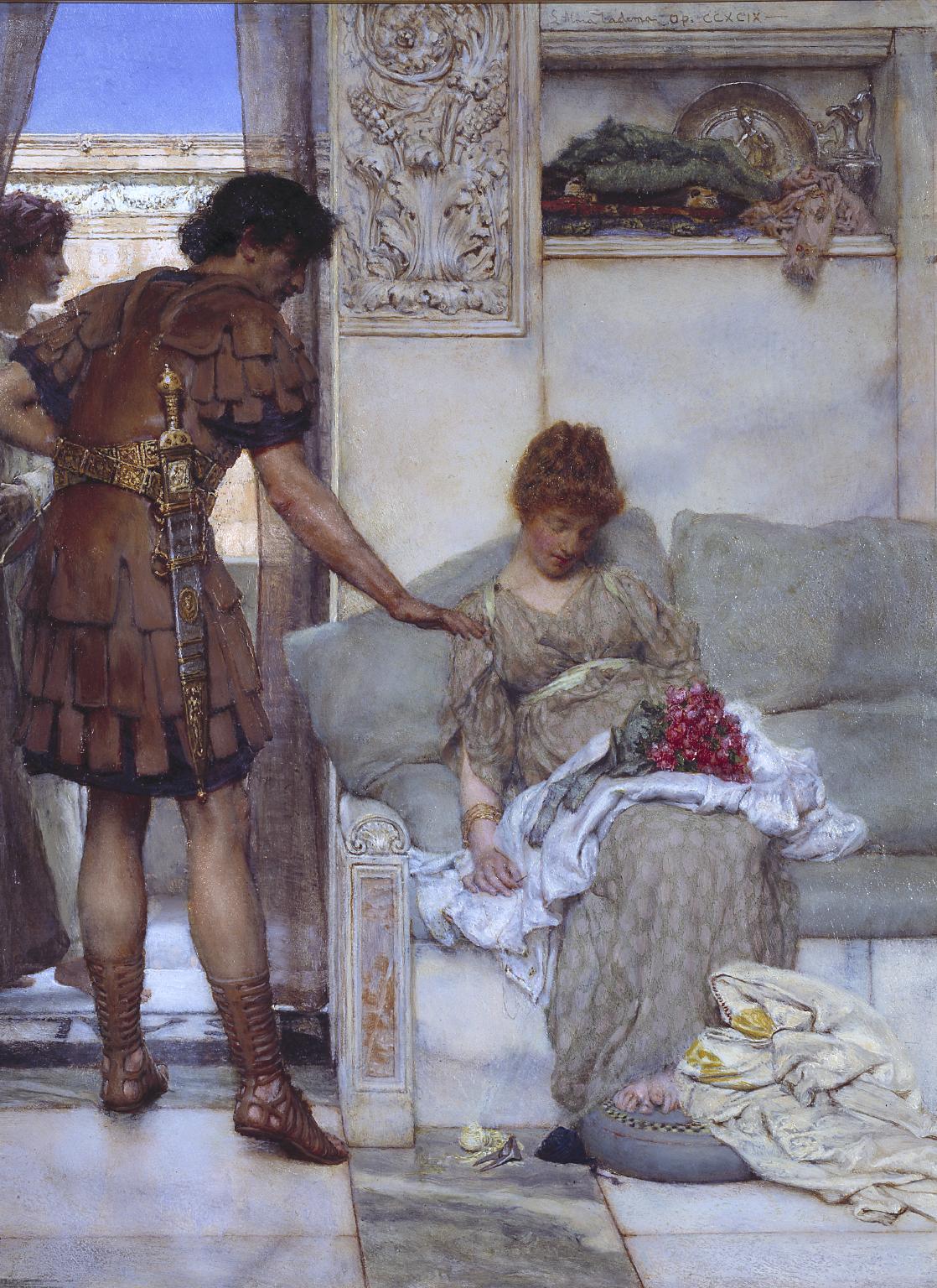
Sir Lawrence Alma-Tadema, A Silent Greeting 1889
The ‘silent greeting’ of the title is the gift of flowers that the young Roman soldier leaves for the sleeping woman. The subject was inspired by The Visit, a poem by the German poet and dramatist Johann Wolfgang von Goethe (1749–1832). Alma-Tadema took great pains over the accuracy of his depictions of the ancient world, carefully researching the architecture and interior details. However, the sentimental subject and the contemporary look of the figures – memorably described as ‘Victorians in togas’ – gives the painting the air of a modern costume drama.
Gallery label, September 2004
1/30
artworks in 1815–1905
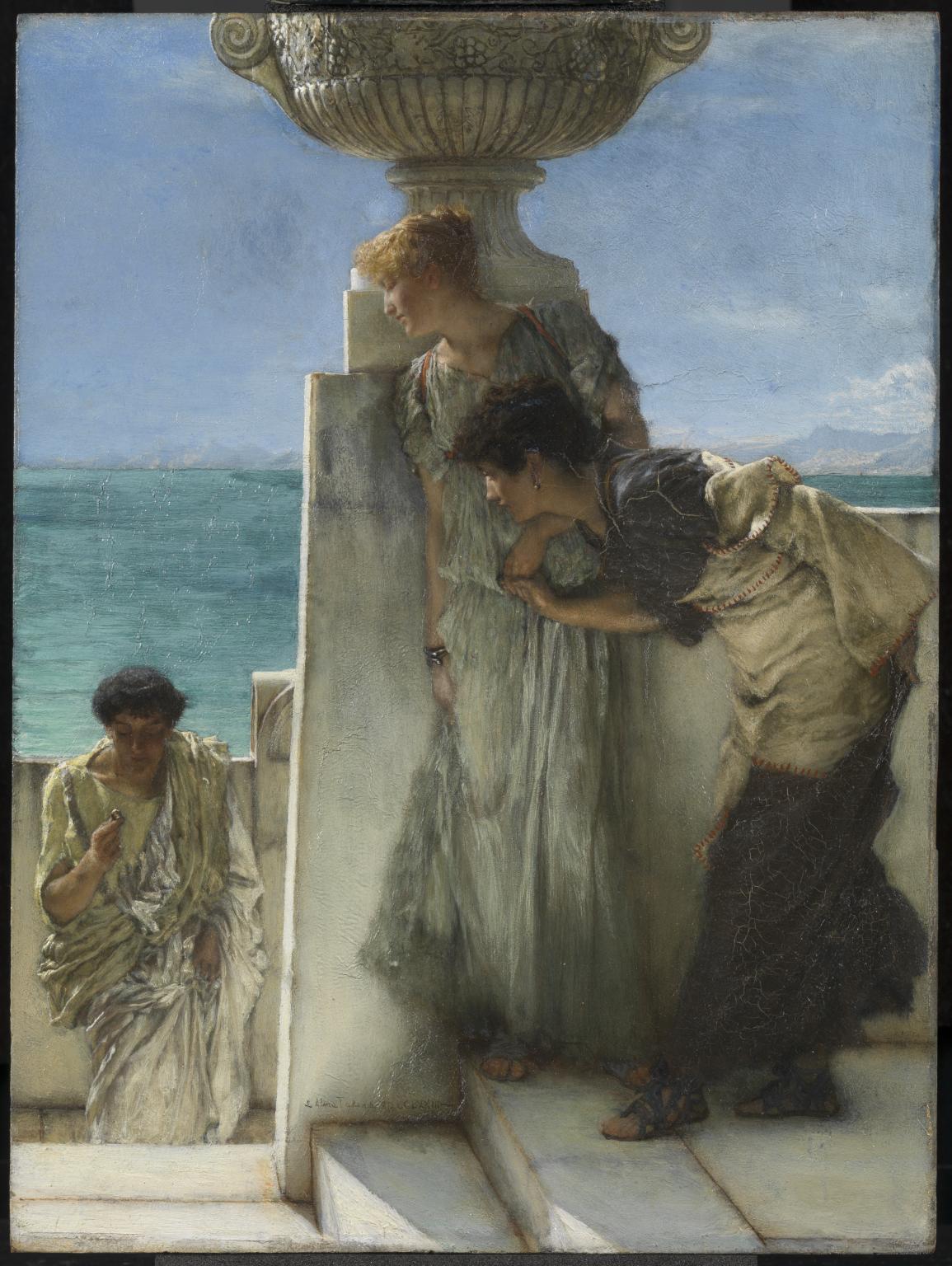
Sir Lawrence Alma-Tadema, A Foregone Conclusion 1885
A moment from contemporary Victorian life is shown here taking place in ancient Greece or Rome. A man brings an engagement ring to his girlfriend in the hope that she will become his fiancée. Her eager attitude shows that the result of his proposal is ‘a foregone conclusion’. Although Alma-Tadema took great care in the authenticity of his classical settings, the modern subject would have made the painting accessible to a nineteenth-century audience. The painting belonged to Sir Henry Tate’s second wife, Amy Hislop. They were married the year it was painted and he may have given it to her as an engagement present.
Gallery label, September 2004
2/30
artworks in 1815–1905
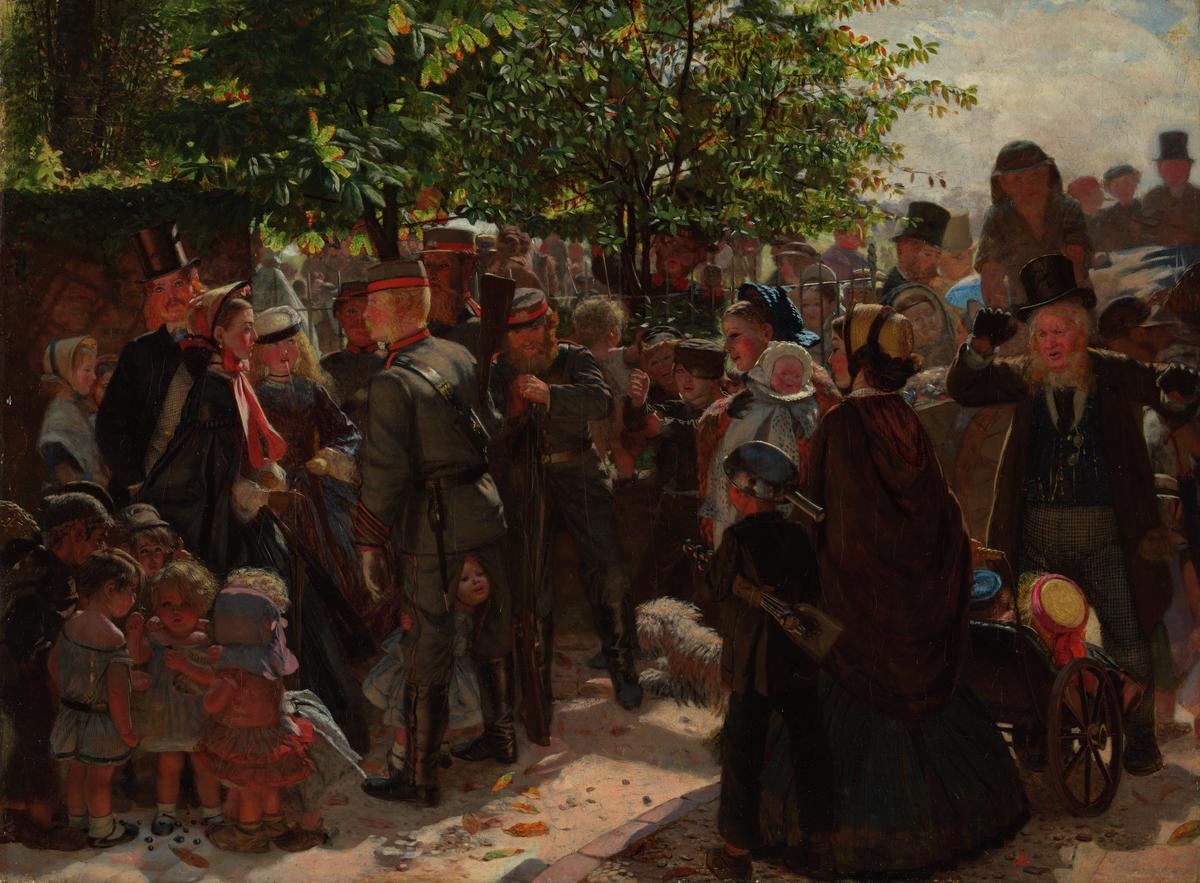
Arthur Boyd Houghton, Volunteers 1861
This painting shows a group of infantrymen recruiting for the Volunteer Movement which swept Britain between 1859 and 1860. It was fuelled by the revolutions in Continental Europe in 1848 and British mistrust of France.As Houghton shows in this painting, the volunteers were mainly recruited from the middle classes. They felt it was their patriotic duty to enlist in one of the volunteer battalions. But there appears to be a general lack of interest from the civilians in this painting. The gentleman on the left is carefully not looking at the soldiers.
Gallery label, July 2007
3/30
artworks in 1815–1905
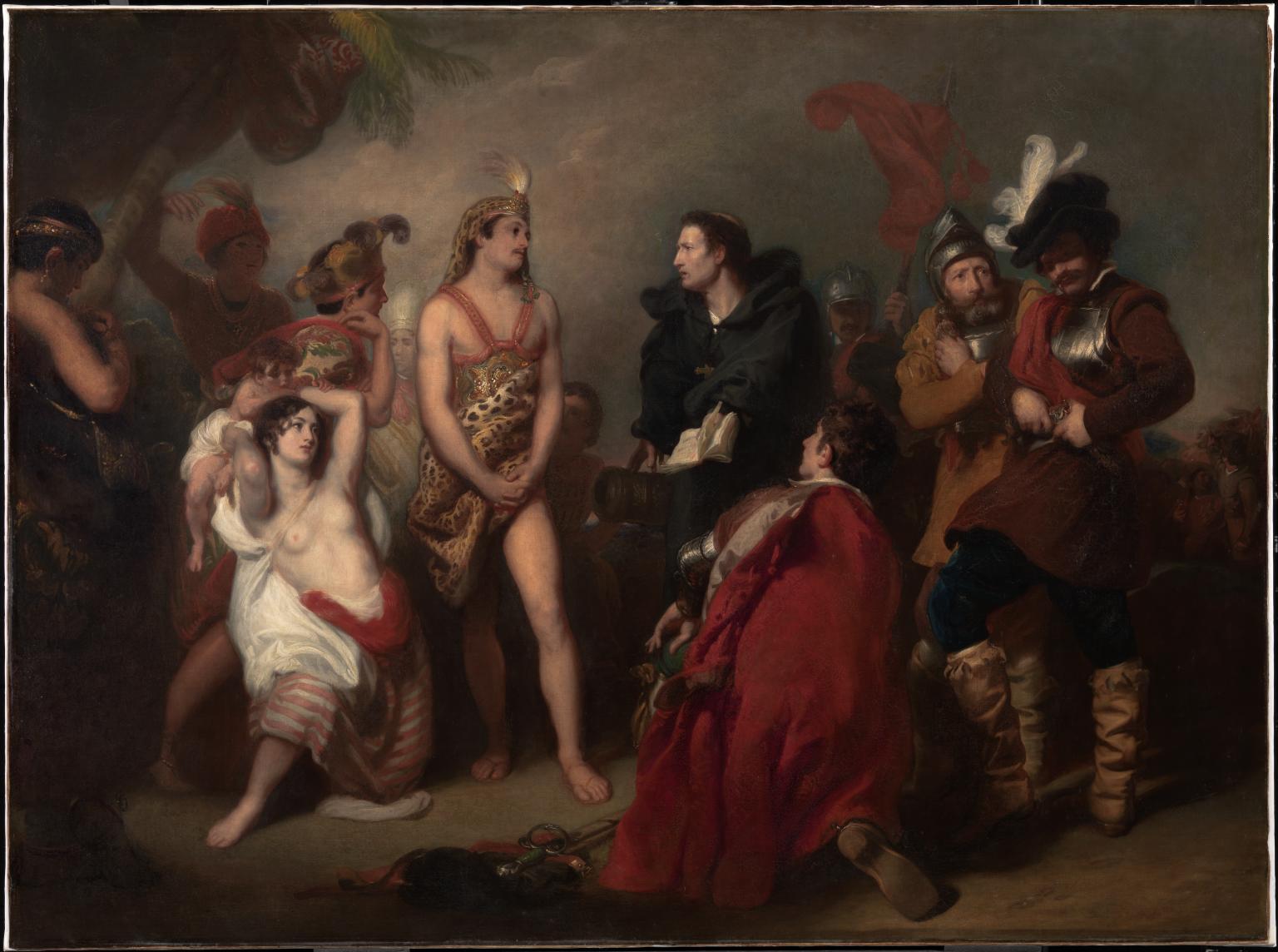
Henry Perronet Briggs, The First Interview between the Spaniards and the Peruvians exhibited 1827
This painting shows an episode from the Spanish conquest of Peru in 1632. The Inca king, Atalhuellpa, is questioning Christian beliefs in front of the chaplain of the Spanish conquistador, Francisco Pizarro. A struggle ensued during which the king was captured and many Incas were slaughtered.
Briggs was one of the few consistently successful history painters of his generation. This picture was exhibited at the British Institution in 1827. Briggs had shown an earlier version of the subject at the Royal Academy the previous year, when it was highly praised, and bought by a friend of Turner's, William Wells of Redleaf.
Gallery label, September 2004
4/30
artworks in 1815–1905
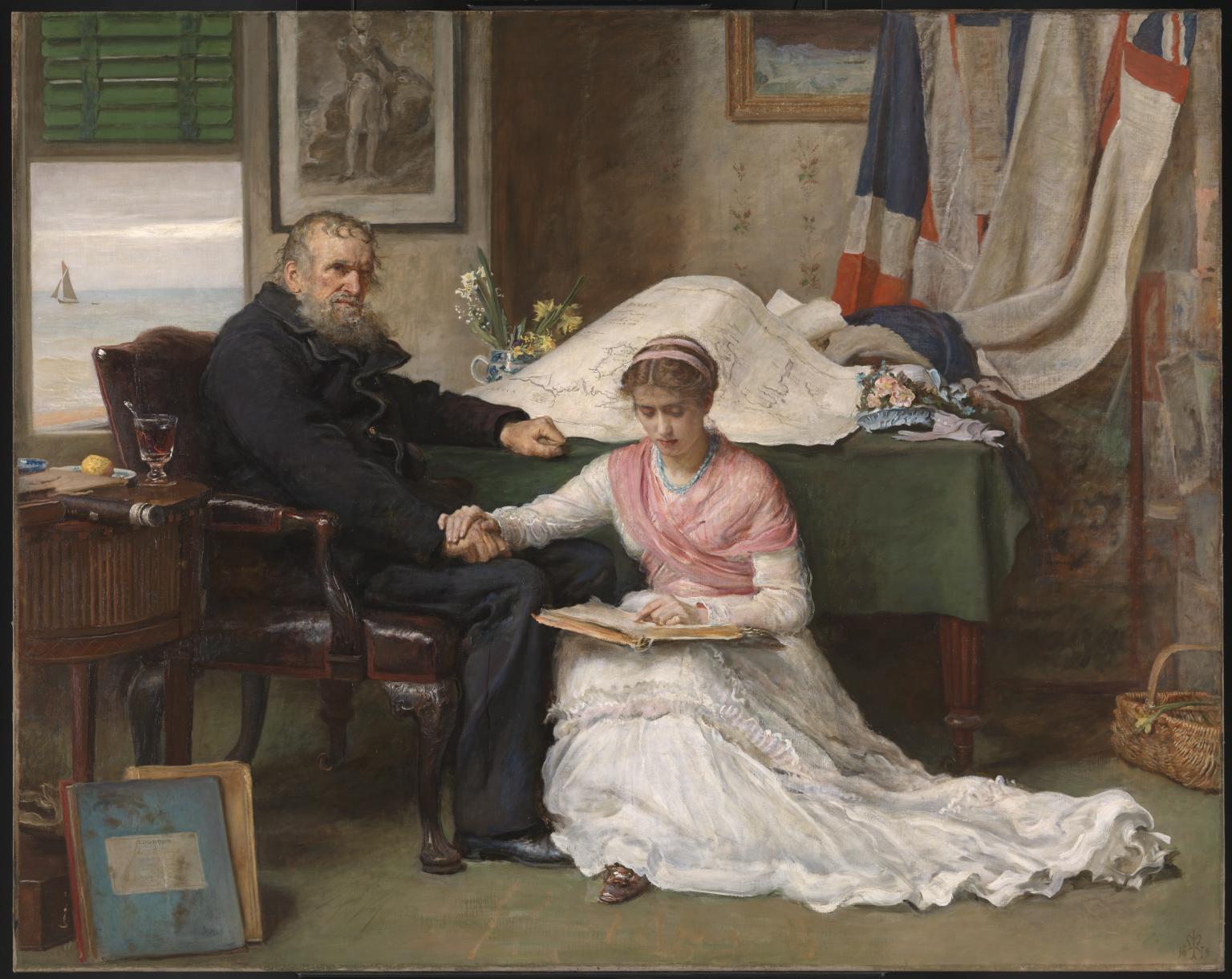
Sir John Everett Millais, Bt, The North-West Passage 1874
The north-west passage is a dangerous sea route round North America via the Canadian Arctic. For centuries, European explorers attempted to use it as a trade route to Asia. It became associated with failure, adversity and death, with ships and their crews battling against hopeless odds in a frozen wilderness. Millais painted this when an English expedition was setting off. Millais suggests the risks of the voyage through the grim expression of the old seaman. His daughter is pictured beside him, reading from a log book.
Gallery label, August 2018
5/30
artworks in 1815–1905
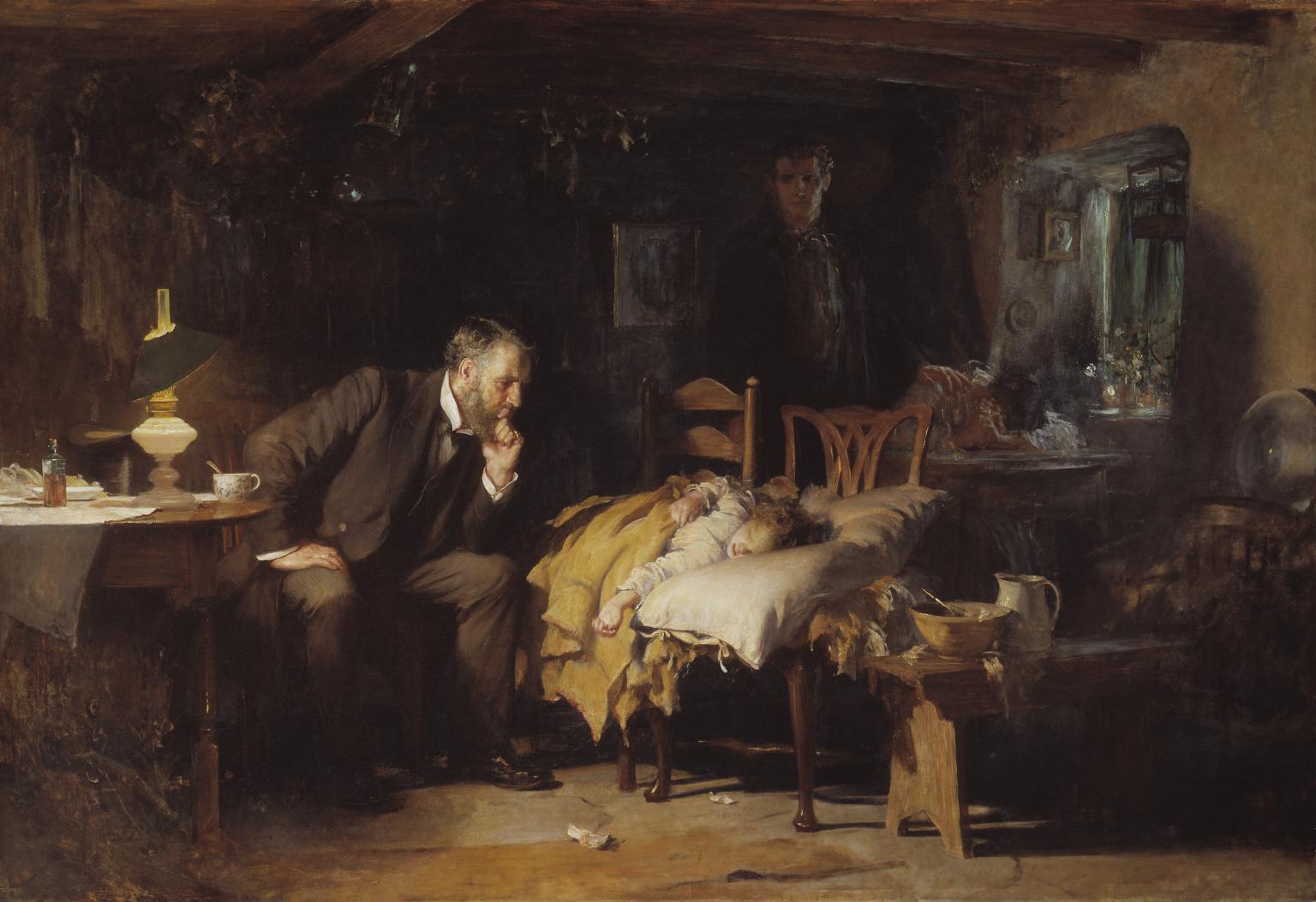
Sir Luke Fildes, The Doctor exhibited 1891
This painting depicts a child showing the first signs of recovery following a period of grave illness. The subject matter relates to a bereavement suffered by Fildes, when in 1877 his first son died at home at the age of one. Here, the figure of the doctor stands as a symbol of quiet professional devotion, capturing, as Fildes put it, ‘the status of the doctor of our time’. Behind the child, a working class father and mother anxiously await the doctor’s assessment. The sliver of dawn light at the window suggests renewed hope in the face of near-tragedy.
Gallery label, March 2022
6/30
artworks in 1815–1905
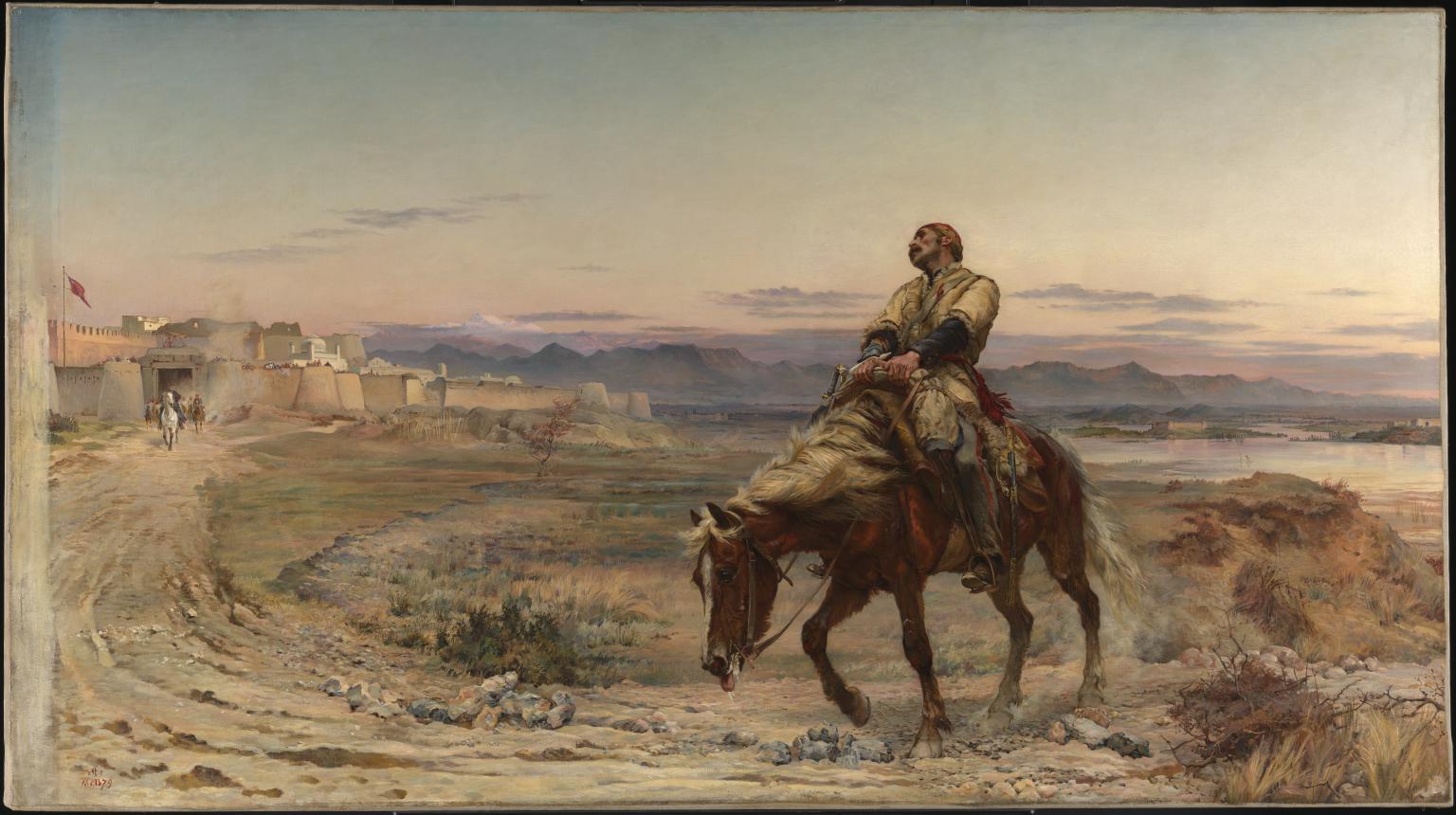
Elizabeth Butler (Lady Butler), The Remnants of an Army 1879
7/30
artworks in 1815–1905

Lady Dorothy Stanley, His First Offence 1896
8/30
artworks in 1815–1905
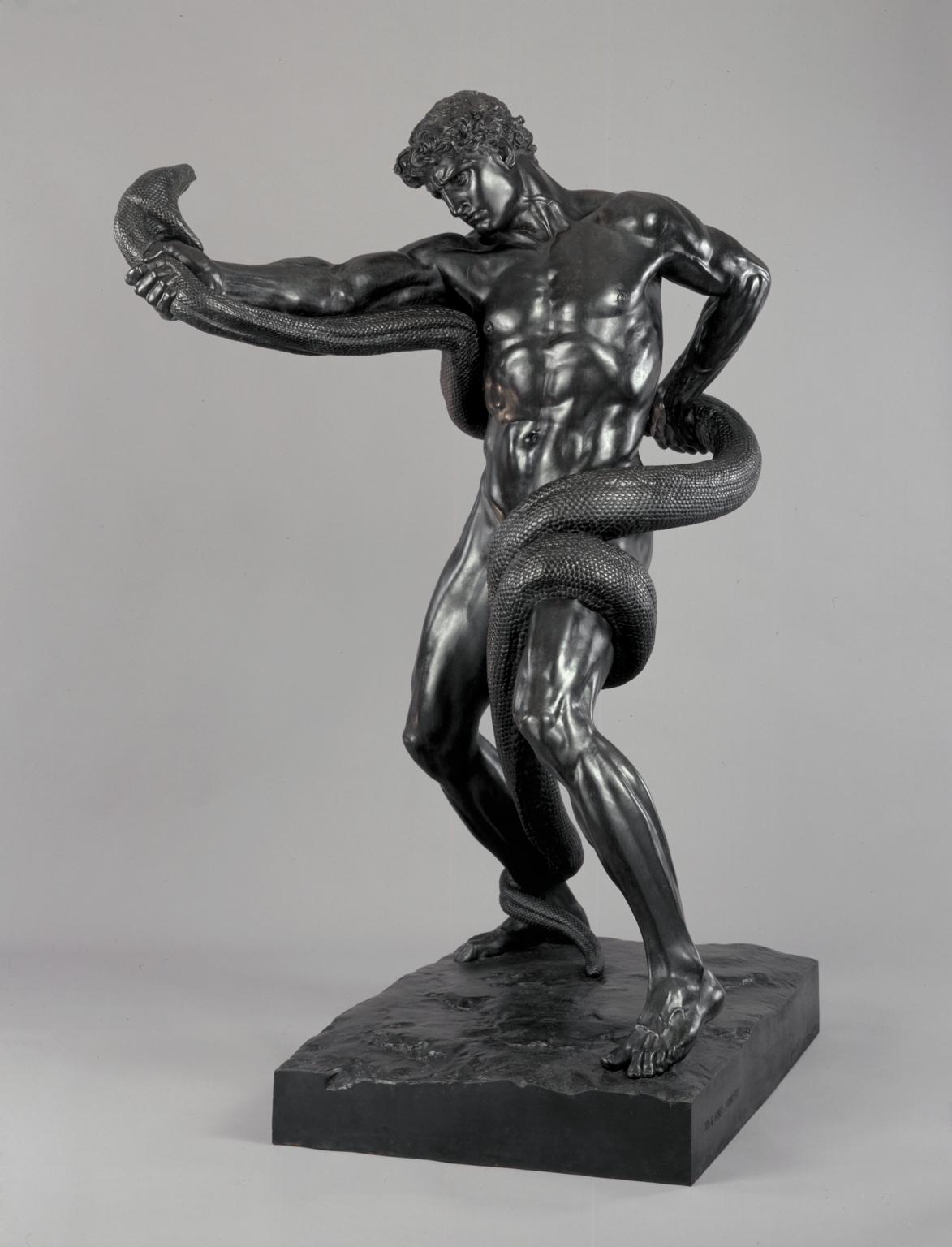
Frederic, Lord Leighton, An Athlete Wrestling with a Python 1877
This is the earlier of Frederic Leighton’s only two life-size sculptures, both made with the assistance of Thomas Brock. In subject and scale it was intended as a challenge to one of the greatest classical sculptures, The Laocoön, which shows three men being crushed by sea serpents. Frederic Leighton was a pioneer of what became known as the ‘New Sculpture’ movement in Britain. This fresh approach looked back to classical sculpture while focusing on the naturalism of the body through careful modelling of the surface. This coincided with a revival of interest in bronze, the lost wax technique used here allowing for precision in the treatment of form.
Gallery label, November 2016
9/30
artworks in 1815–1905
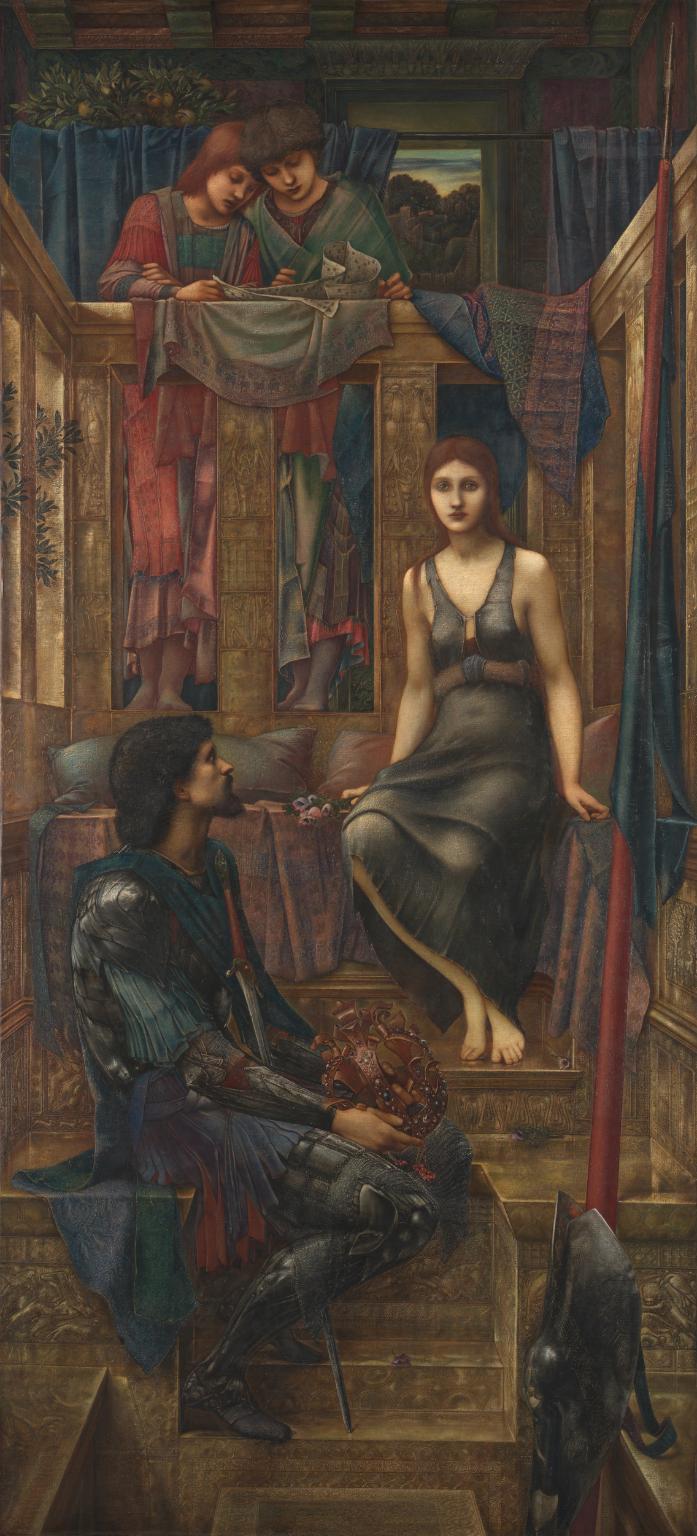
Sir Edward Coley Burne-Jones, Bt, King Cophetua and the Beggar Maid 1884
This work was based on Alfred Tennyson’s poem ‘The Beggar Maid’. King Cophetua of Ethiopia falls in love with Penelophon, a young woman he sees begging for money. They marry, and she becomes Queen. This work was considered Burne-Jones’s greatest achievement. Critics praised it for its technical skill and for the message that love is more important than wealth and power. Through this painting and its reproduction as a print, Burne-Jones became seen in Europe as the most important symbolist painter of his generation.
Gallery label, August 2019
10/30
artworks in 1815–1905
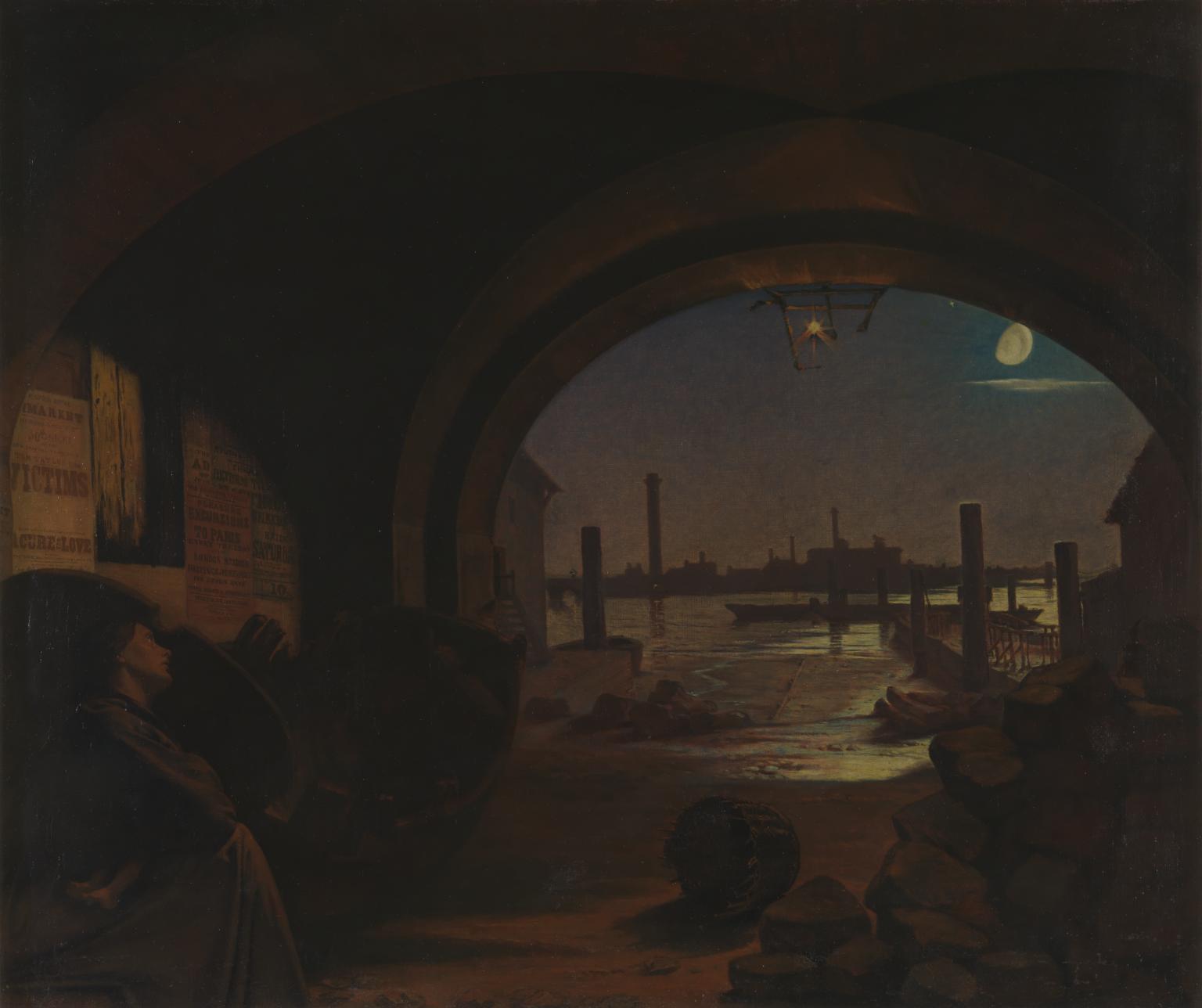
Augustus Leopold Egg, Past and Present, No. 3 1858
The final scene in this series is set under the Adelphi arches, by the River Thames in London. A woman shelters her young child, having been made to leave the family home following an affair. The posters behind her advertise two plays – Victims and A Cure for Love – and Pleasure Excursions to Paris. These are ironic comments on her situation. In Victorian Britain, an affair was far more serious for a woman than a man. During debates about divorce in 1857, the Lord Chancellor testified that a ‘wife might …condone an act of adultery on the part of the husband; but a husband could not condone a similar act on the part of a wife’.
Gallery label, August 2019
11/30
artworks in 1815–1905
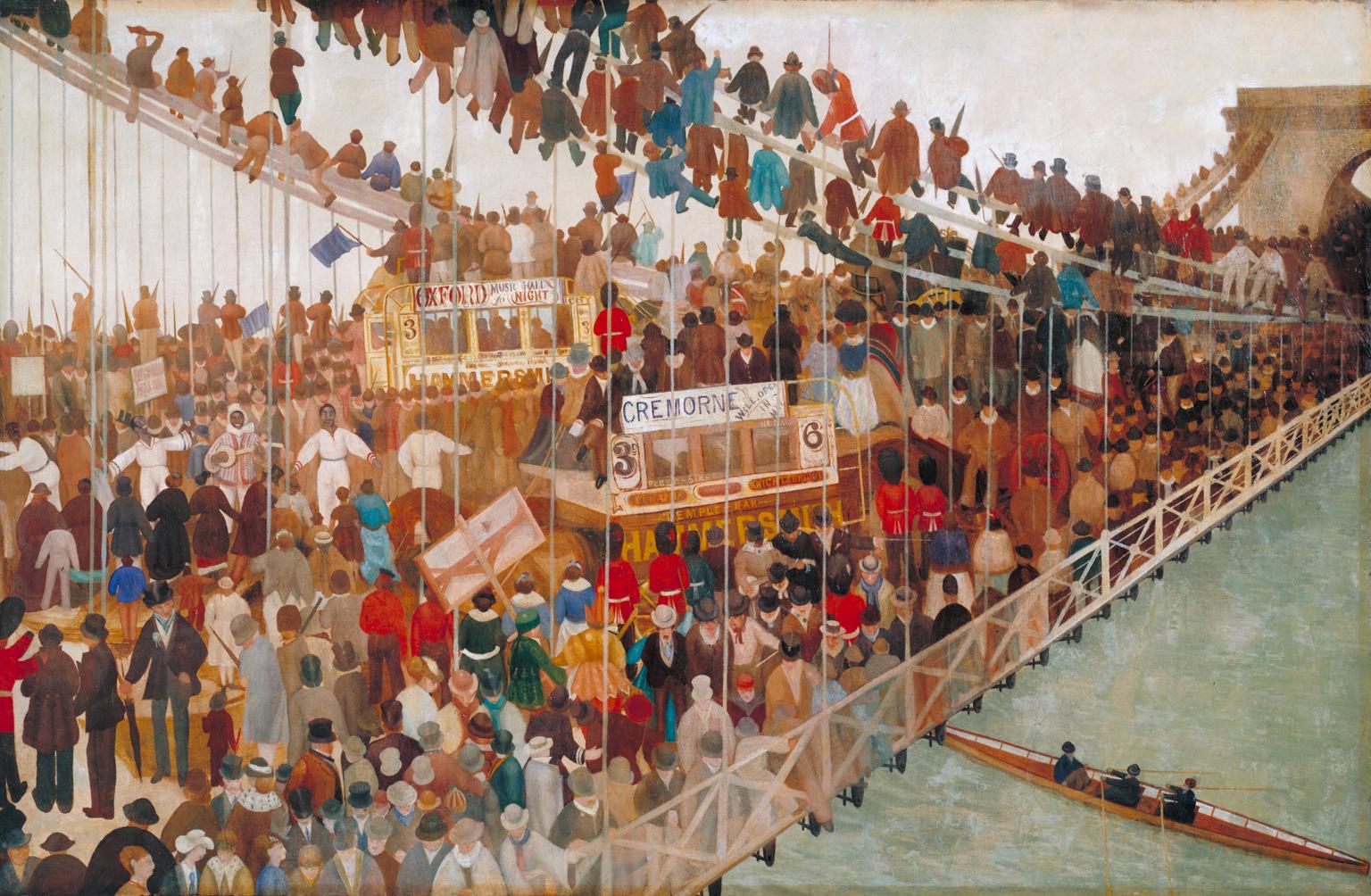
Walter Greaves, Hammersmith Bridge on Boat-race Day c.1862
Greaves was the son of a Thames boatman and a self-taught painter. His painting shows a dense crowd assembled on Hammersmith suspension bridge to watch the annual university boat race. In 1870 around 12,000 people gathered there for the event giving rise to fears that the bridge was not strong enough to support the weight of heavy traffic. The current bridge, designed by the civil engineer Joseph Bazalgette, opened in 1887. This rests on the original piers depicted in the painting.
Gallery label, November 2016
12/30
artworks in 1815–1905
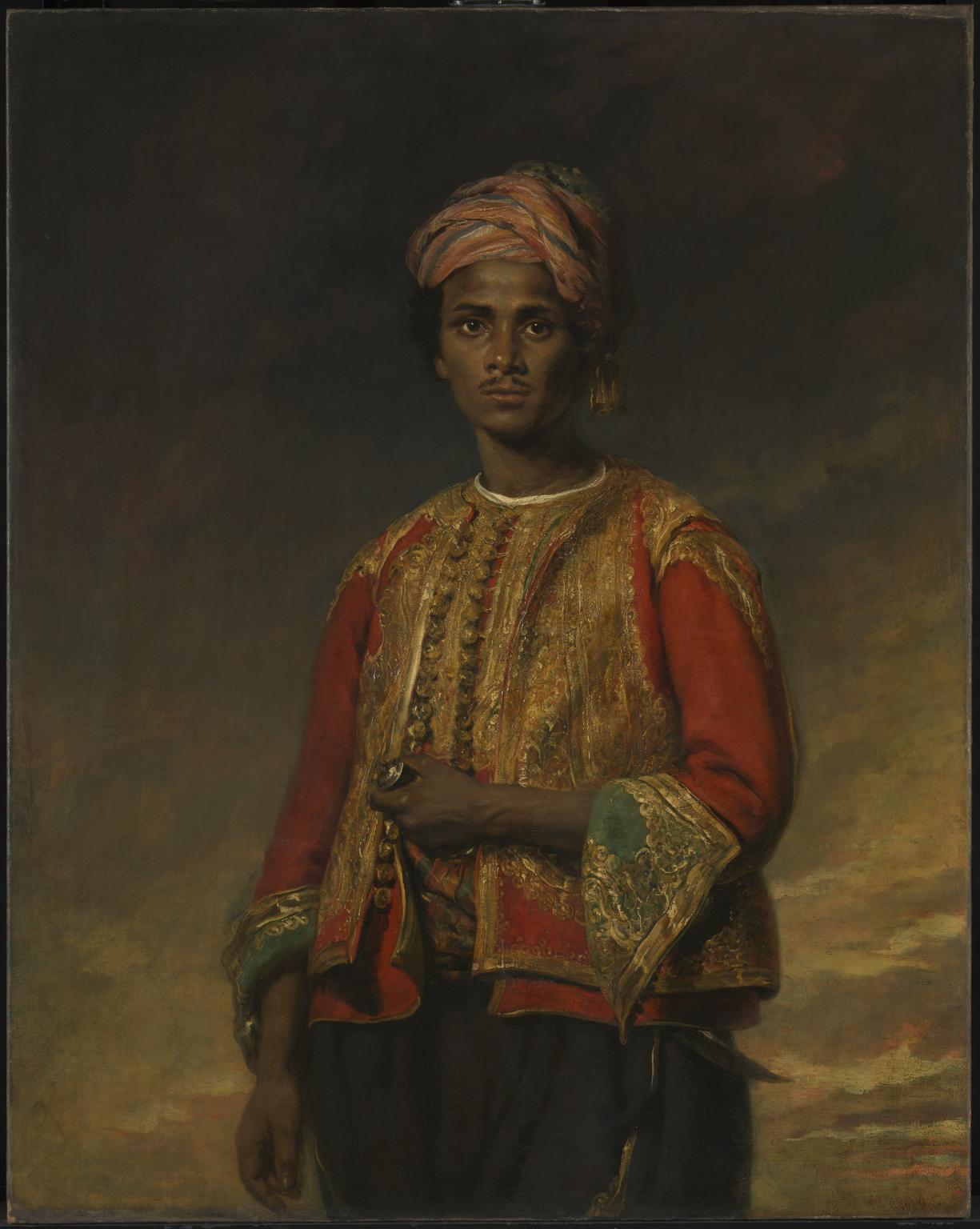
Unknown artist, Britain, Unknown Man c.1830–40
The artist who painted this work is unknown, as is the identity of the young man represented here. The sitter’s luxurious jacket and waistcoat are Albanian, but his turban and loose trousers appear to be Turkish or North-African. The picture follows conventions of portraiture, with its focus on the man’s facial features and high-status dress. The combination of different styles, however, suggests that the figure might be intended to represent a fictional character, rather than a real person. At the time, in portraits like this, black people were often depicted dressed in costume and not named.
Gallery label, November 2018
13/30
artworks in 1815–1905
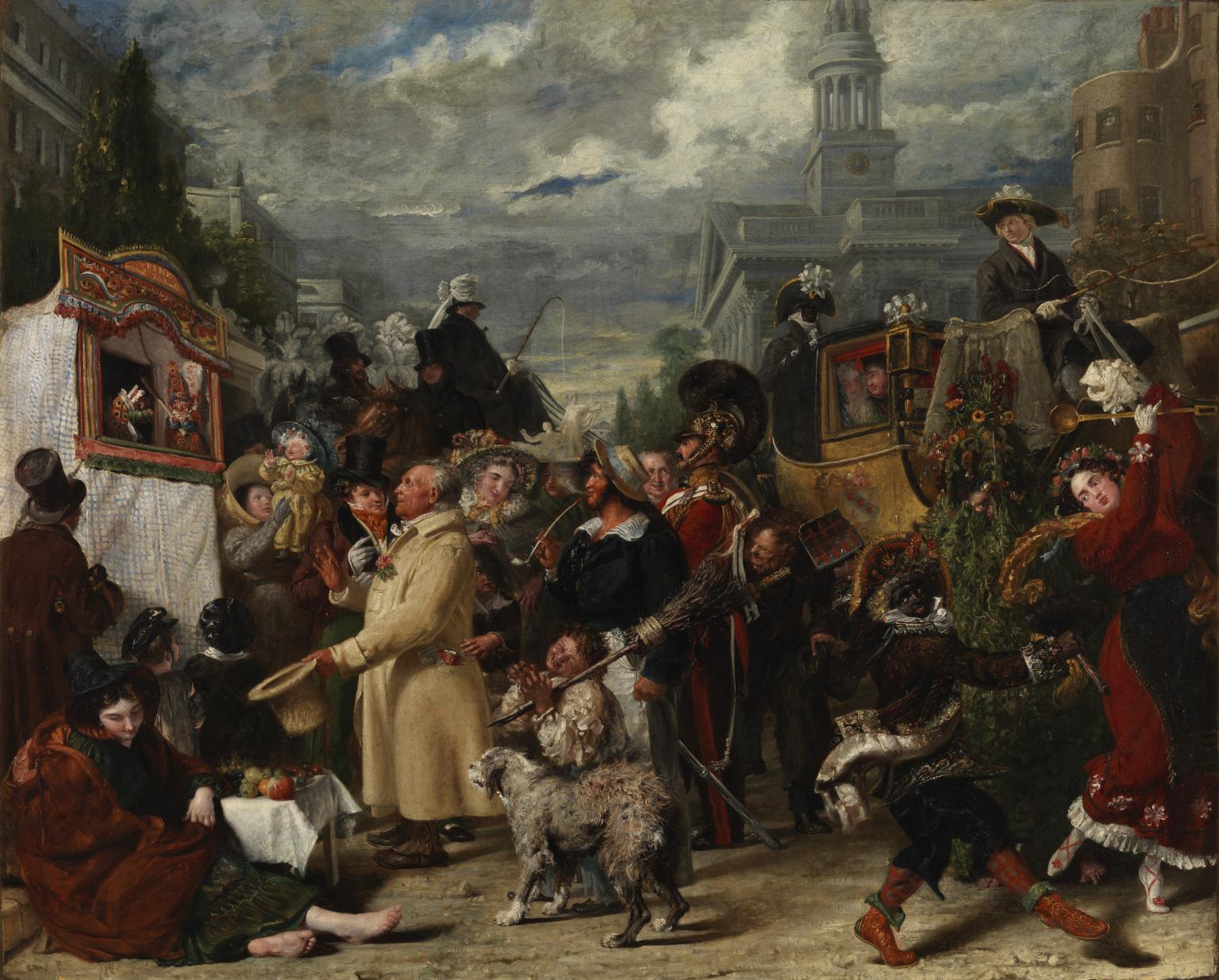
Benjamin Robert Haydon, Punch or May Day 1829
Haydon thought of calling this painting ‘Life’, reflecting his ambition to capture a cross-section of London. His composition is full of pairings and contrasts. A hearse and a marriage coach nearly collide. The newly-weds are contrasted with the violent Punch and Judy puppet show on the left. Christianity, as represented by St Marylebone Church, co-exists with the pre-Christian May Day procession in the foreground on the right. Part of this parade is a dancing chimney sweep with blond curls and soot-blackened face. This performance of ‘blackness’ contrasts with the artist’s treatment of the black footman standing at the back of the carriage.
Gallery label, July 2018
14/30
artworks in 1815–1905
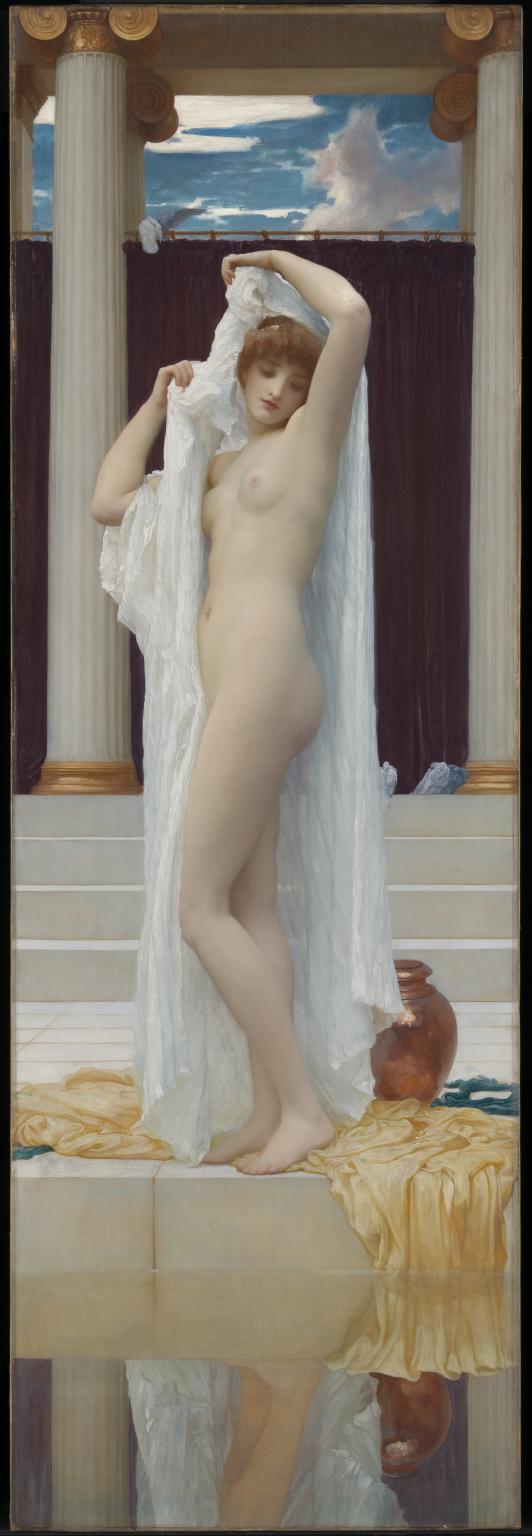
Frederic, Lord Leighton, The Bath of Psyche exhibited 1890
The story of Psyche comes from a tale by the Roman poet Lucius Apuleius. Psyche lived in the golden palace of Cupid, the god of love. Each night Cupid would visit Psyche’s bedroom to have sex with her, without revealing his identity. Here we see Psyche undressing to bathe before Cupid’s arrival, gazing at her reflection. Leighton based Psyche’s pose on an ancient statue of Venus Leaving the Bath that he’d seen in Naples in 1859. He may also have designed the frame, which echoes the architectural details in the background of the picture.
Gallery label, August 2019
15/30
artworks in 1815–1905
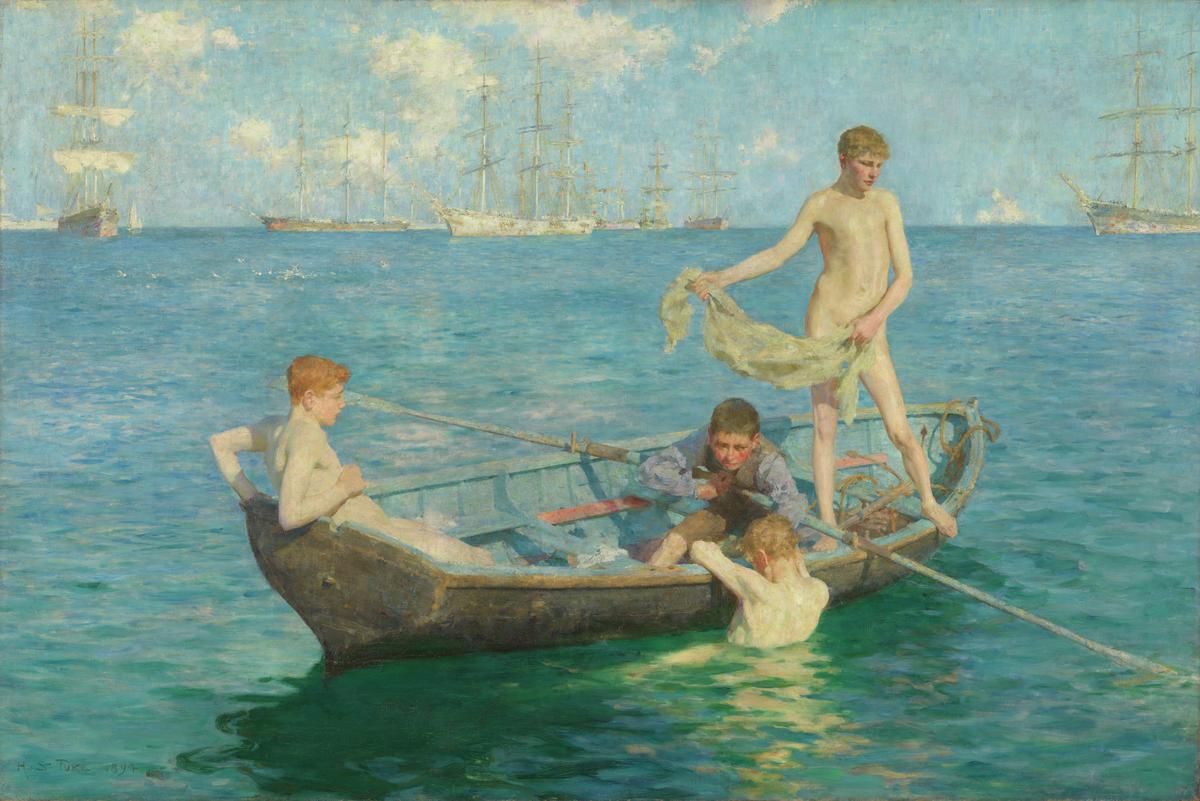
Henry Scott Tuke, August Blue 1893–4
This is one of many pictures Tuke painted of boys bathing around Falmouth Harbour, a common scene at the time. Tuke worked from life and photographs but he idealised the scene. Its poetic title (from Algernon Swinburne’s poem ‘The Sundew’ 1866) reflects the colour that suffuses the composition. Tuke grew up in Cornwall and helped found the Newlyn School, a group of artists based in Newlyn. He was well-known for his portraits of boats as well as people.
Gallery label, September 2020
16/30
artworks in 1815–1905
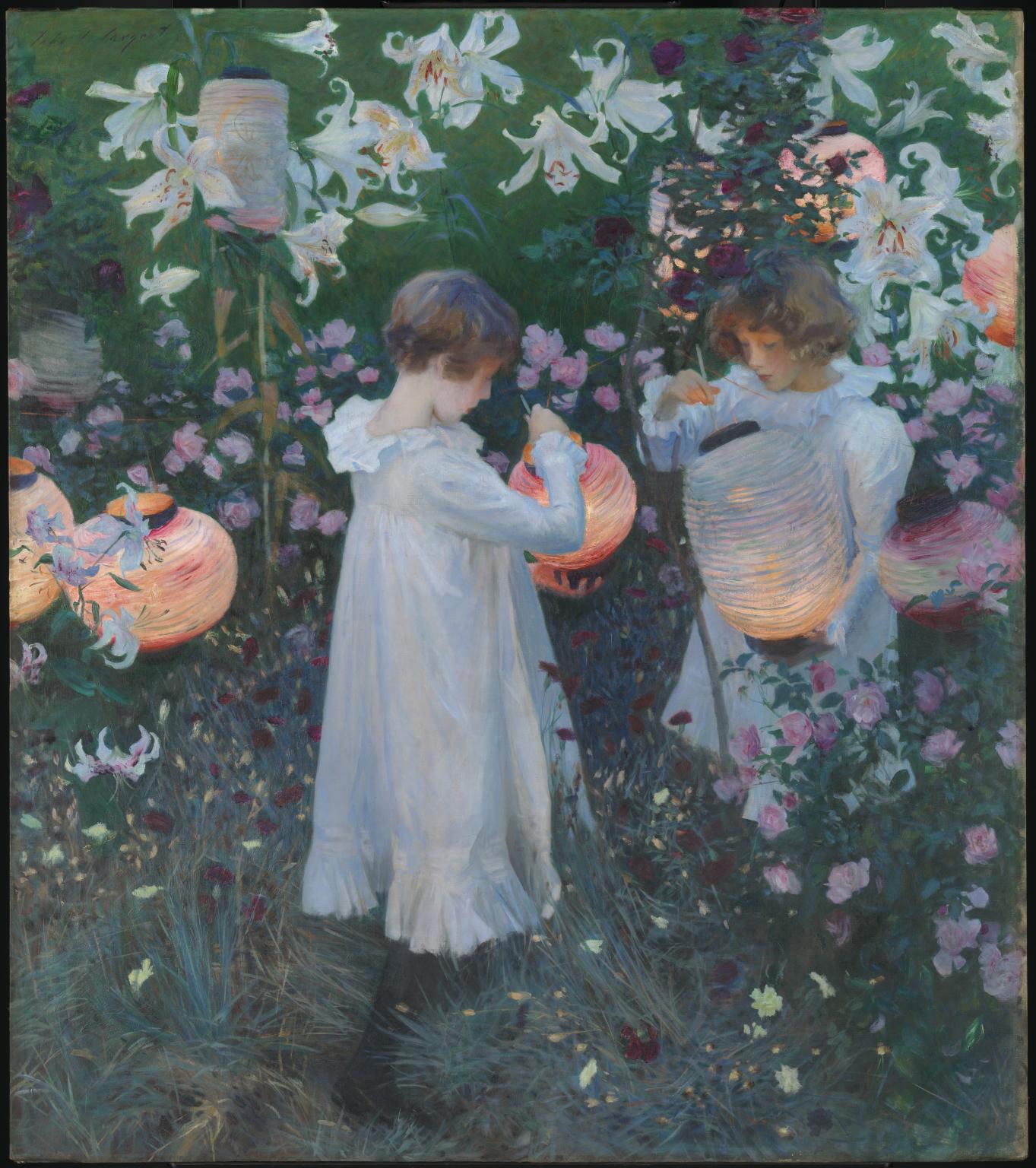
John Singer Sargent, Carnation, Lily, Lily, Rose 1885–6
The children lighting lanterns are Dolly (left) and Polly (right) Barnard. Their father, illustrator Frederick Barnard, was friends with Sargent. It was painted in a garden in Broadway, a village in south west England where Sargent stayed in the summer of 1885.Sargent wanted to paint from real life. There were only a few minutes each evening where the light was right. He would place his easel and paints, pose the models beforehand, and wait for the right moment to start. As summer ended and the flowers died, he replaced them with pot plants.
Gallery label, July 2020
17/30
artworks in 1815–1905
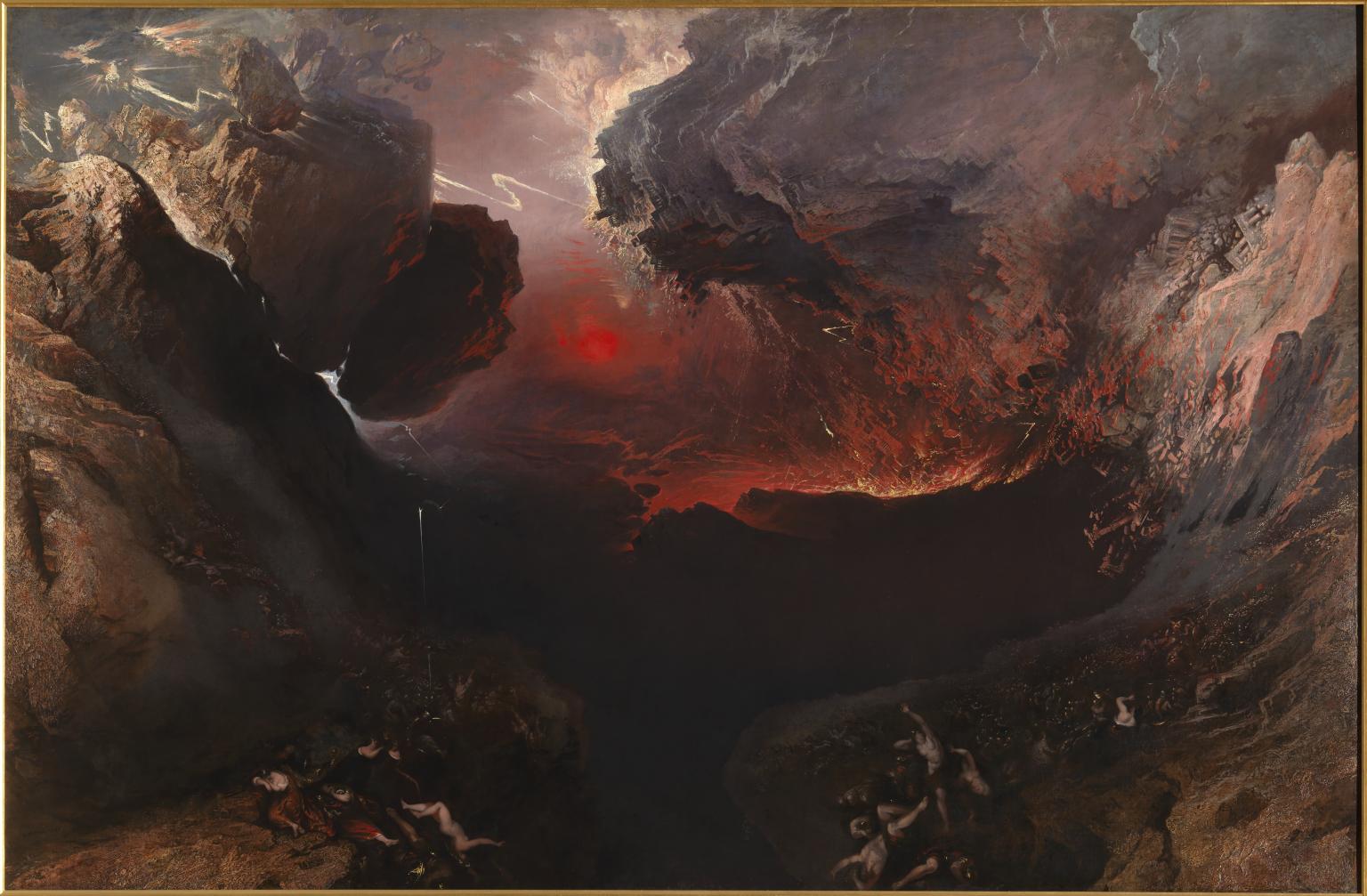
John Martin, The Great Day of His Wrath 1851–3
American filmmaker and stop-motion animator Ray Harryhausen (1920 – 2013) was inspired by Martin’s dramatic works. He called this painting ‘an incredible, visionary masterpiece, depicting catastrophe and conveying an overwhelming sense of destruction … it resembles a frame from a movie – this time, perhaps, a blockbuster disaster movie’.
Gallery label, August 2019
18/30
artworks in 1815–1905
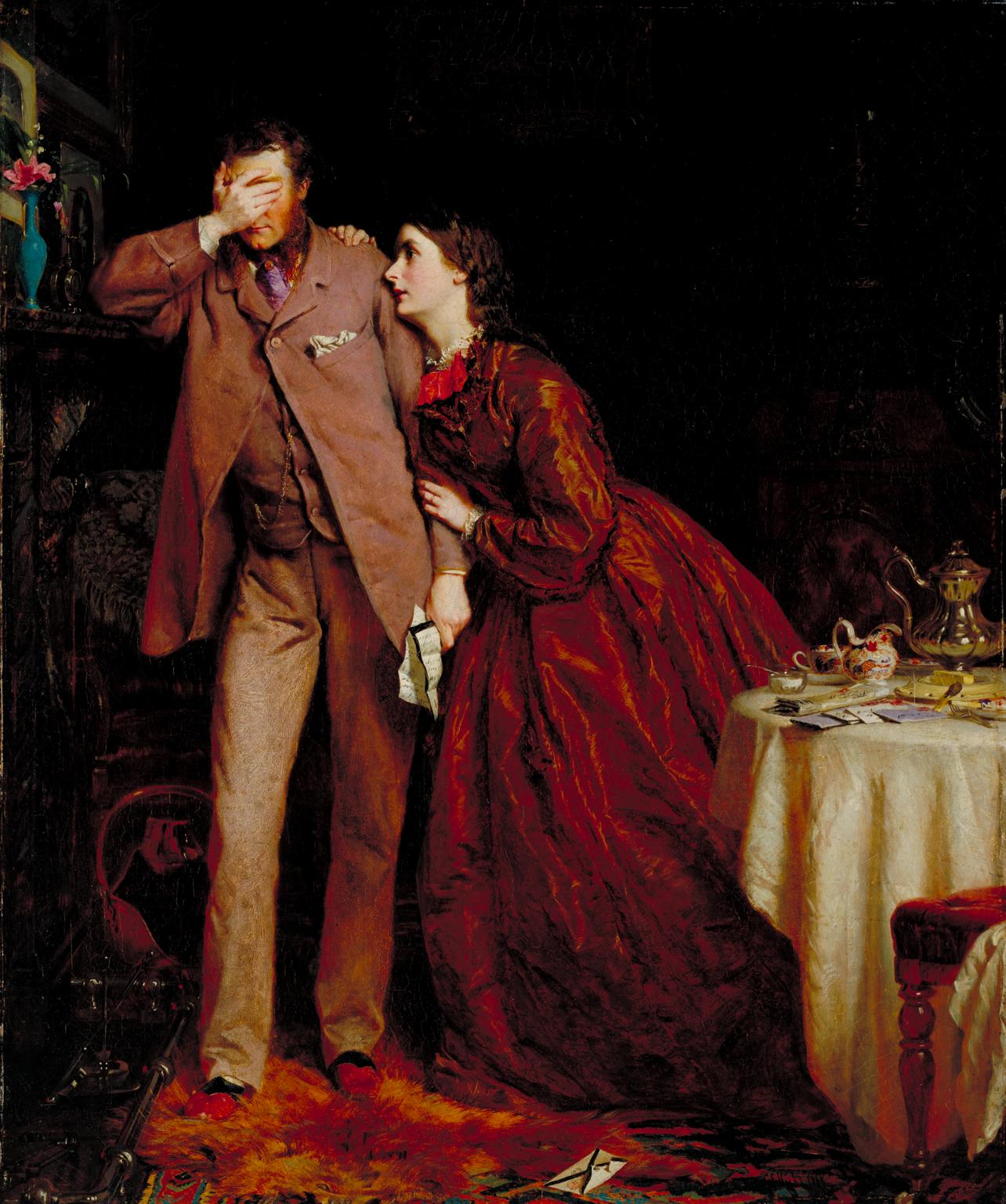
George Elgar Hicks, Woman’s Mission: Companion of Manhood 1863
These two paintings make up two scenes in a triptych (three-part picture) called Woman’s Mission which was exhibited at the Royal Academy in 1863. The missing section is Guide of Childhood. As a group the pictures represent the same woman in her role as mother, wife and attentive daughter or, as one critic of the time put it: ‘woman in three phases of her duties as ministering angel’. The woman in both pictures bears a striking resemblance to the artist’s depictions of his own wife, Maria.
Gallery label, November 2016
19/30
artworks in 1815–1905
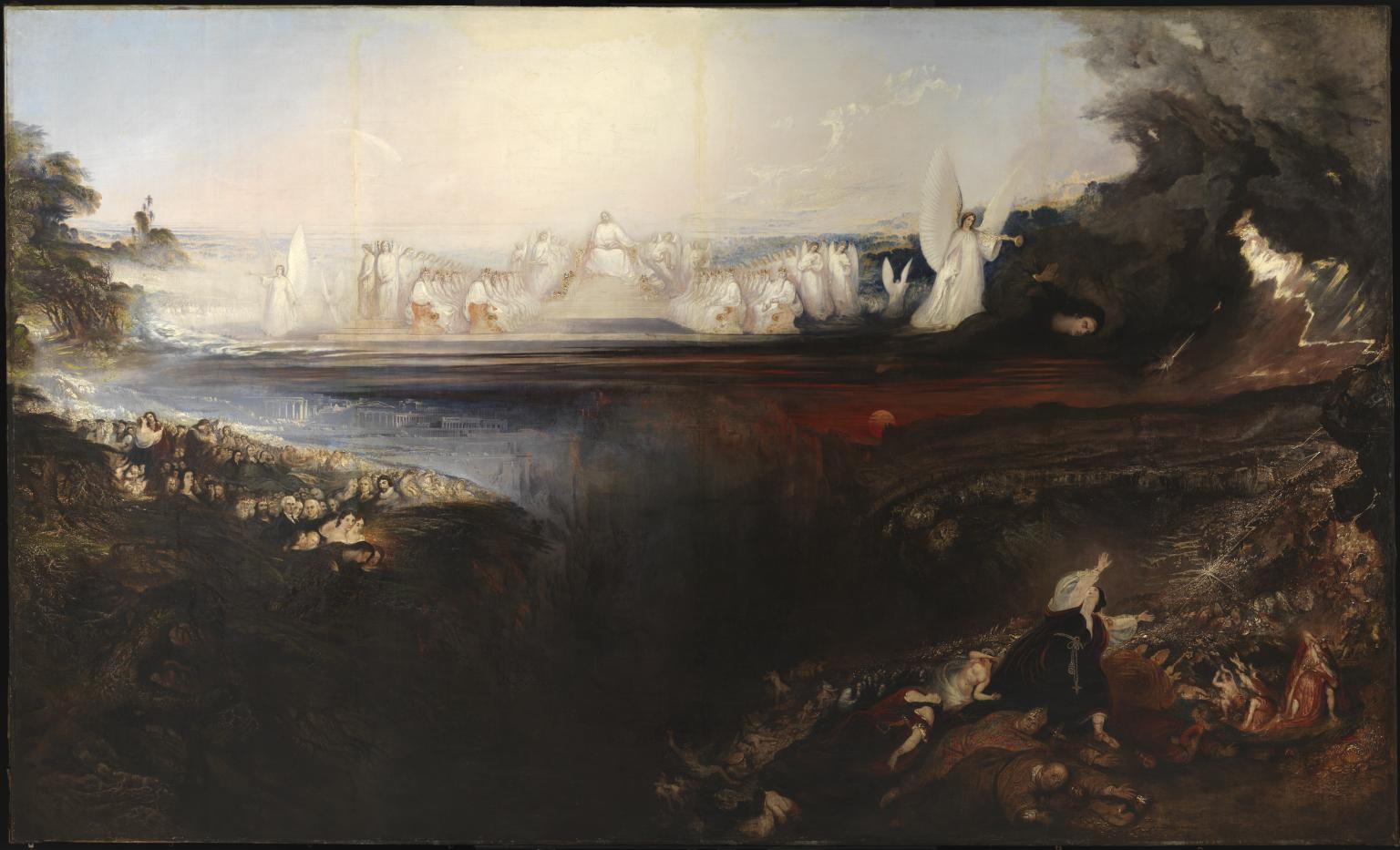
John Martin, The Last Judgement 1853
This was part of a triptych (series of three works), with The Great Day of His Wrath and The Plains of Heaven. The pictures were produced at the end of John Martin’s career, with the intention of touring them. They travelled extensively, even going on show in America and Australia. Their fame and influence helped pave the way for modern forms of popular entertainment – including blockbuster cinema.
Gallery label, August 2019
20/30
artworks in 1815–1905
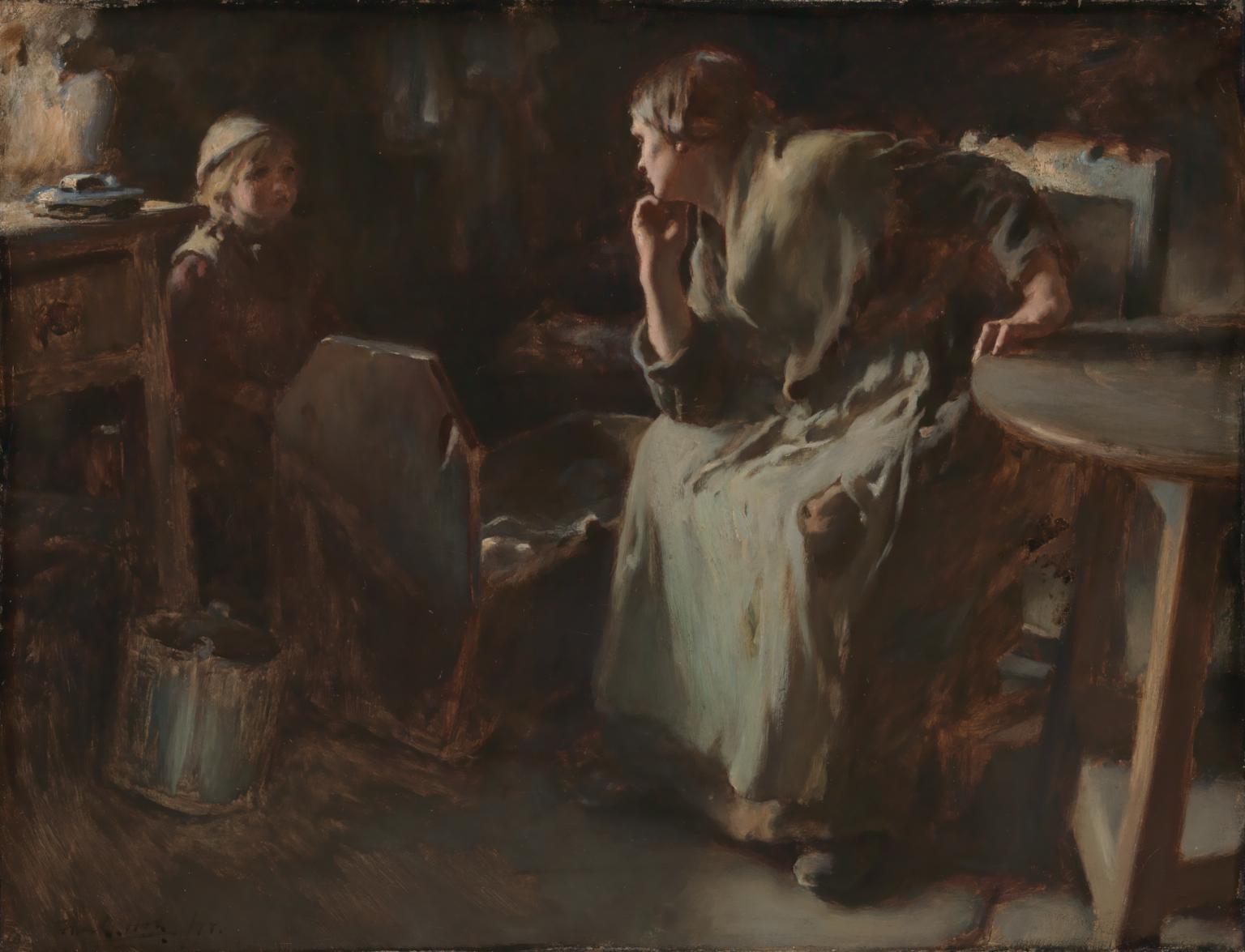
Frank Holl, Hush! 1877
Child death was a common occurrence in Victorian society. These two pictures were once described as ‘a pathetic little story in two chapters’. In Hush a mother devotedly watches over her sick baby, her anxiety mirrored in the face of an older child. Hushed, its companion piece, shows the baby’s death.The mother covers her face with her hand in the universal gesture of grief, while her other child appears bewildered. Holl confronts his subject directly, without sentimentality. The sombre colouring and the strong contrasts between light and shade serve to heighten the grim mood.
Gallery label, July 2007
21/30
artworks in 1815–1905
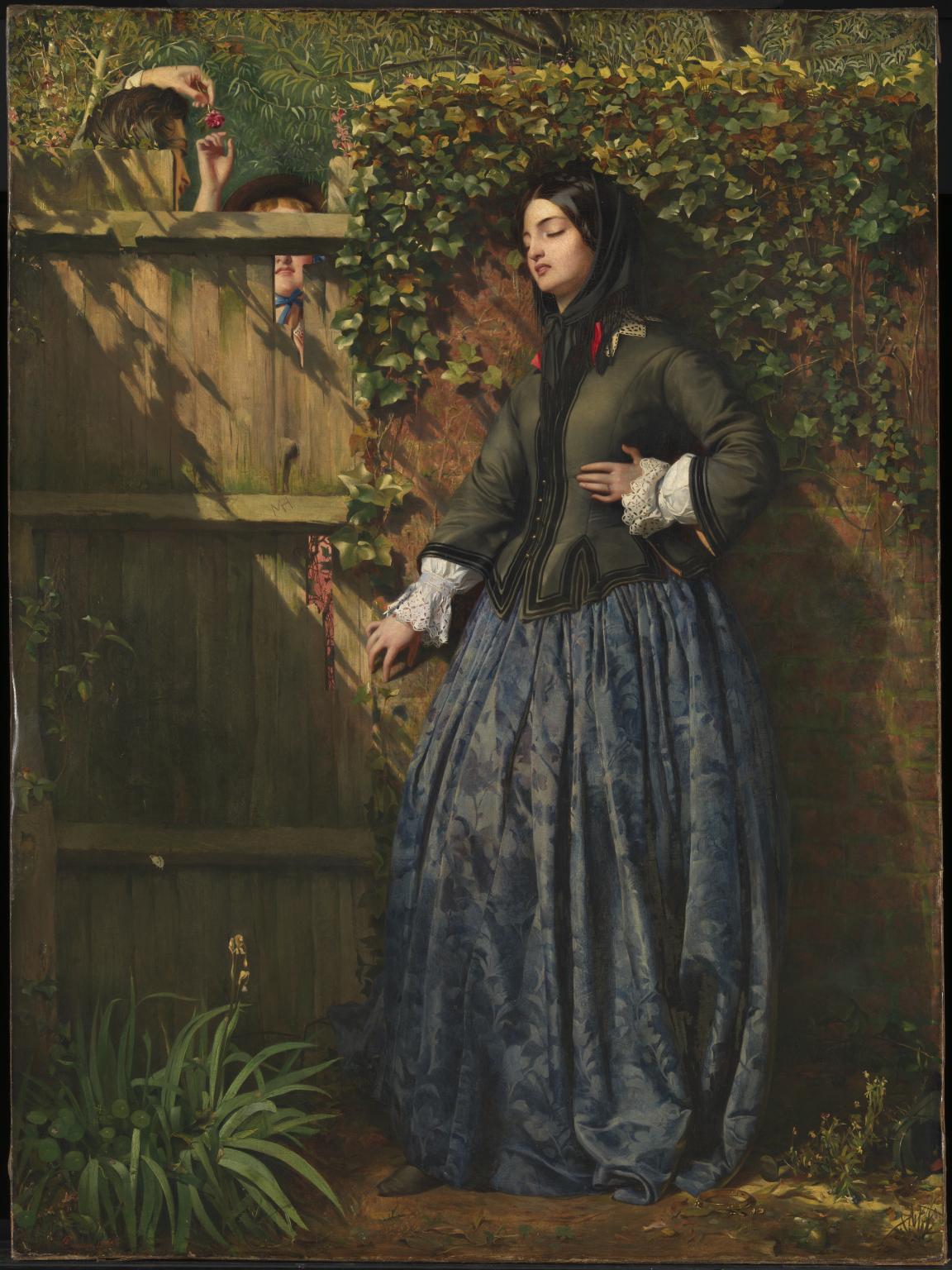
Philip Hermogenes Calderon, Broken Vows 1856
The title of this painting suggests that the woman has recently discovered that her lover, whose initials are carved in the fence, has been unfaithful. Further details, including the discarded necklace and dying flowers, indicate her unhappy situation. The ivy-covered wall may symbolise her previous belief that their love was everlasting. Disappointed love was a popular theme in Victorian painting, and viewers were expected to unravel the situation from the symbols and expressions of the characters.
Gallery label, July 2007
22/30
artworks in 1815–1905
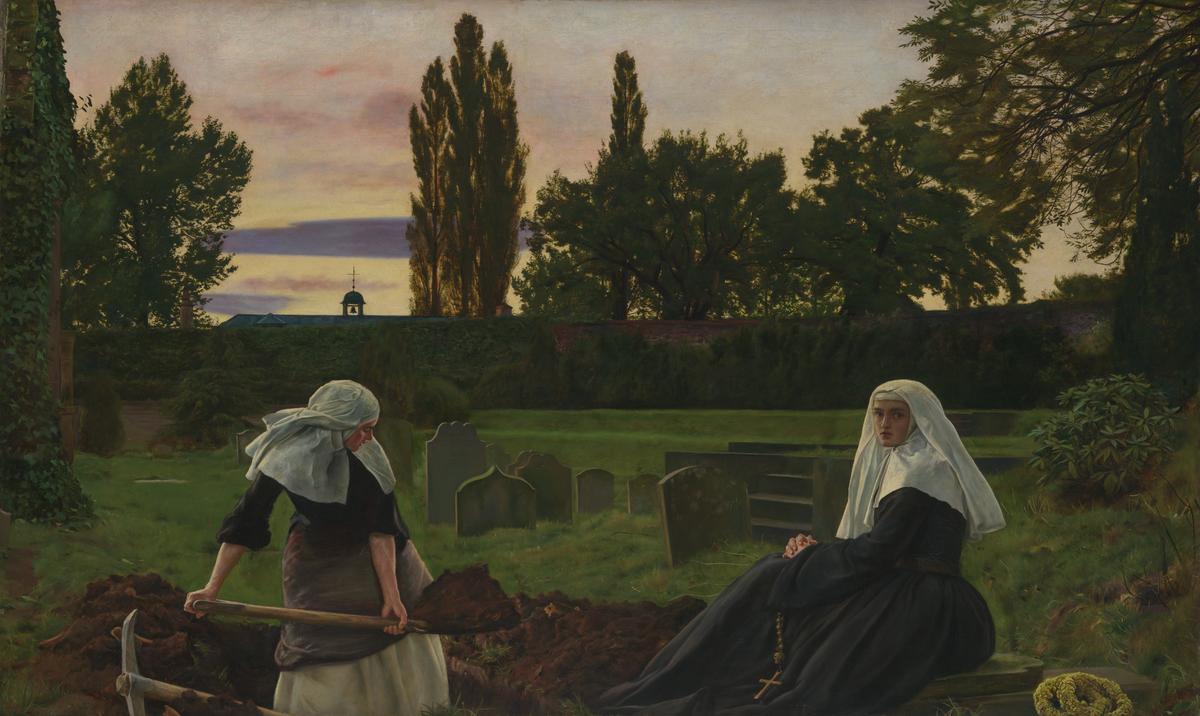
Sir John Everett Millais, Bt, The Vale of Rest 1858–9
Stirred by the spirituality and yearning in Mendelssohn’s song ‘Ruhetal’, here Millais’s theme is death, signified by the presence of the grave, skull and funerary wreaths, and in the intense and solemn colours of a graveyard touched with the last rays of a setting sun. Viewers are invited to contemplate their own mortality through the preparation of the new grave in the foreground and the nun who gazes out towards them. Despite the pain and sadness in death, the title offers hope that it will bring repose from life’s cares and an infinite contentment.
Gallery label, March 2010
23/30
artworks in 1815–1905
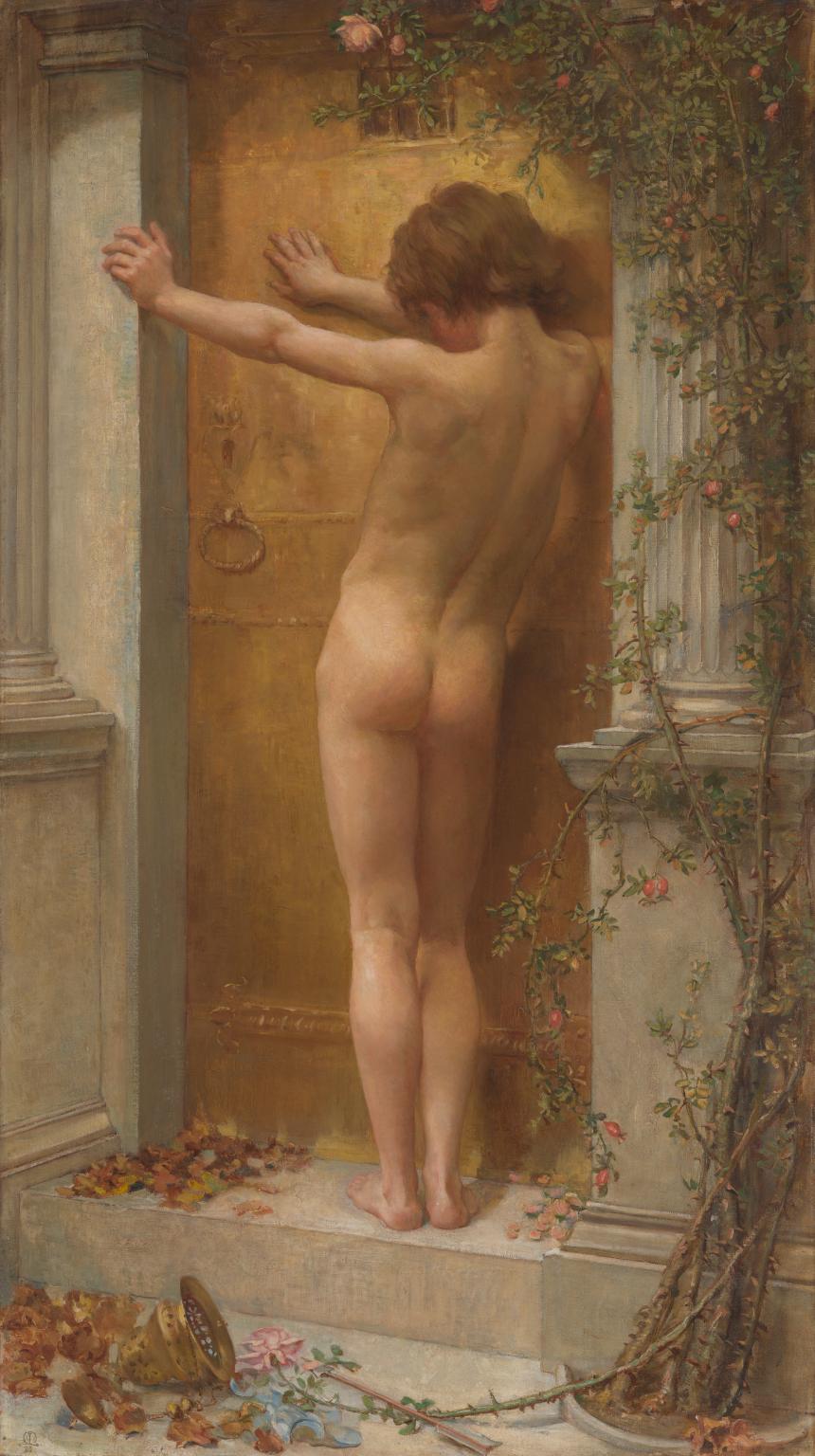
Anna Lea Merritt, Love Locked Out 1890
This picture shows young Cupid, the god of desire, pressed against the door of a tomb. It was painted as a memorial to the artist’s husband, who died just two months after they married. The thorny rose around the door frame represents the pain and persistence of love. Cupid has abandoned the world, his arrow and extinguished lamp lie on the ground with the autumn leaves. He is waiting, in the artist’s words, ‘for the door of death to open and the reunion of the lonely pair’. Merritt was a successful professional painter of a variety of subjects, including nudes. Some considered nudes unsuitable for women artists at the time. Love Locked Out proved popular when exhibited in 1890 and was bought for the nation.
Gallery label, August 2019
24/30
artworks in 1815–1905

Emily Mary Osborn, Nameless and Friendless. “The rich man’s wealth is his strong city, etc.” - Proverbs, x, 15 1857
This painting addresses the plight of a single woman trying to make a living in a hostile environment. A young woman in mourning dress offers a picture to a dealer whose expression suggests rejection. Osborn was actively involved in the campaign for women’s rights that gathered momentum in the mid-19th century. Her painting was probably intended as a political statement as its exhibition at the Royal Academy in 1857 coincided with the formation of the Society of Female Artists, an organisation aimed at enabling women to exhibit and sell their work in public.
Gallery label, November 2016
25/30
artworks in 1815–1905
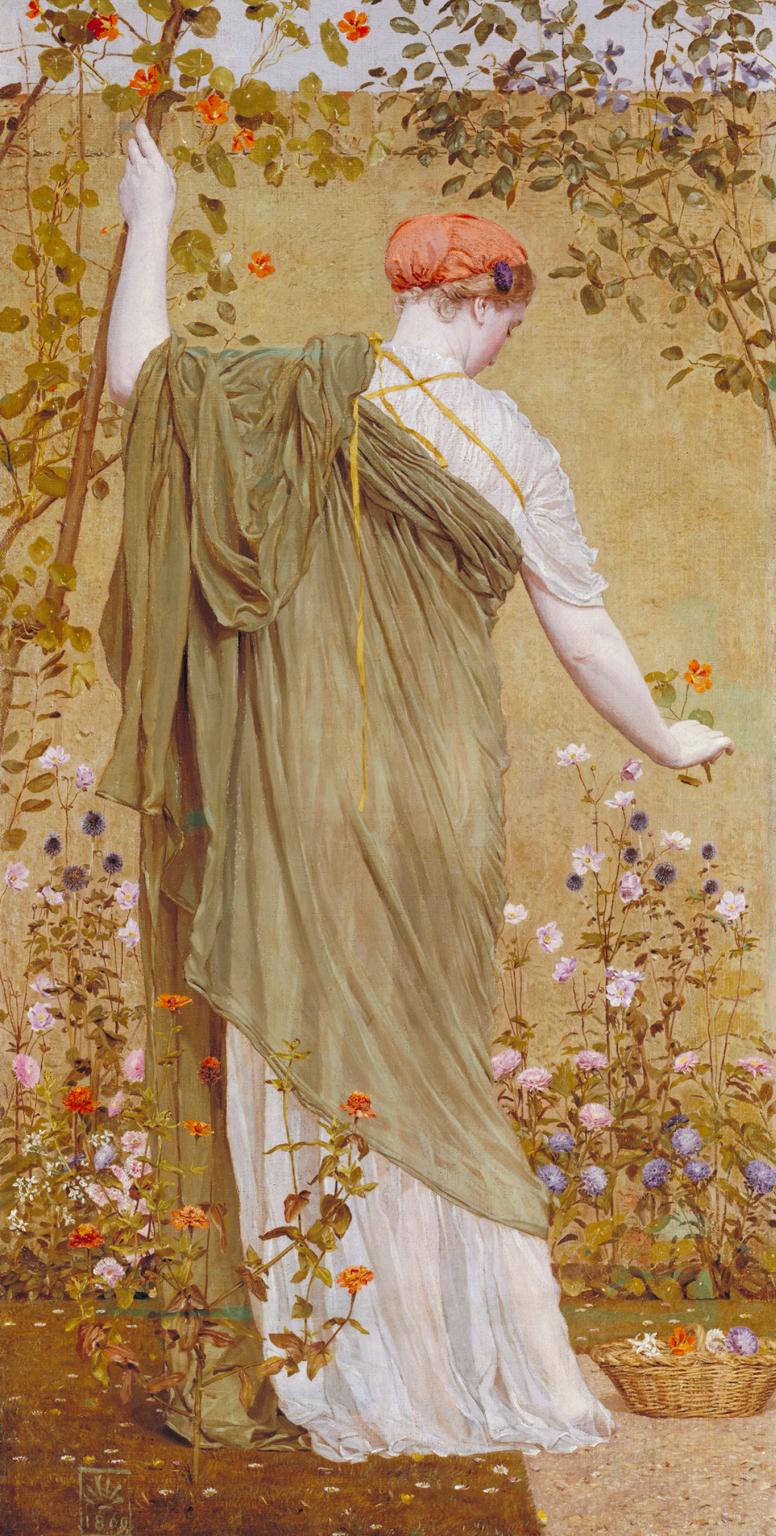
Albert Moore, A Garden 1869
Moore, like many of his contemporaries, was influenced by Japanese art. He produced decorative and subtly coloured pictures. Here, the woman’s costume allows him to concentrate on the colour, texture and movement of draped fabric. Art critic Sidney Colvin said Moore’s subjects were ‘merely a mechanism for getting beautiful people into beautiful situations’. The flower-like symbol at the bottom of the picture was used by Moore as a signature.
Gallery label, August 2018
26/30
artworks in 1815–1905
Sorry, no image available
Thomas Faed, The Last of the Clan 1865
27/30
artworks in 1815–1905
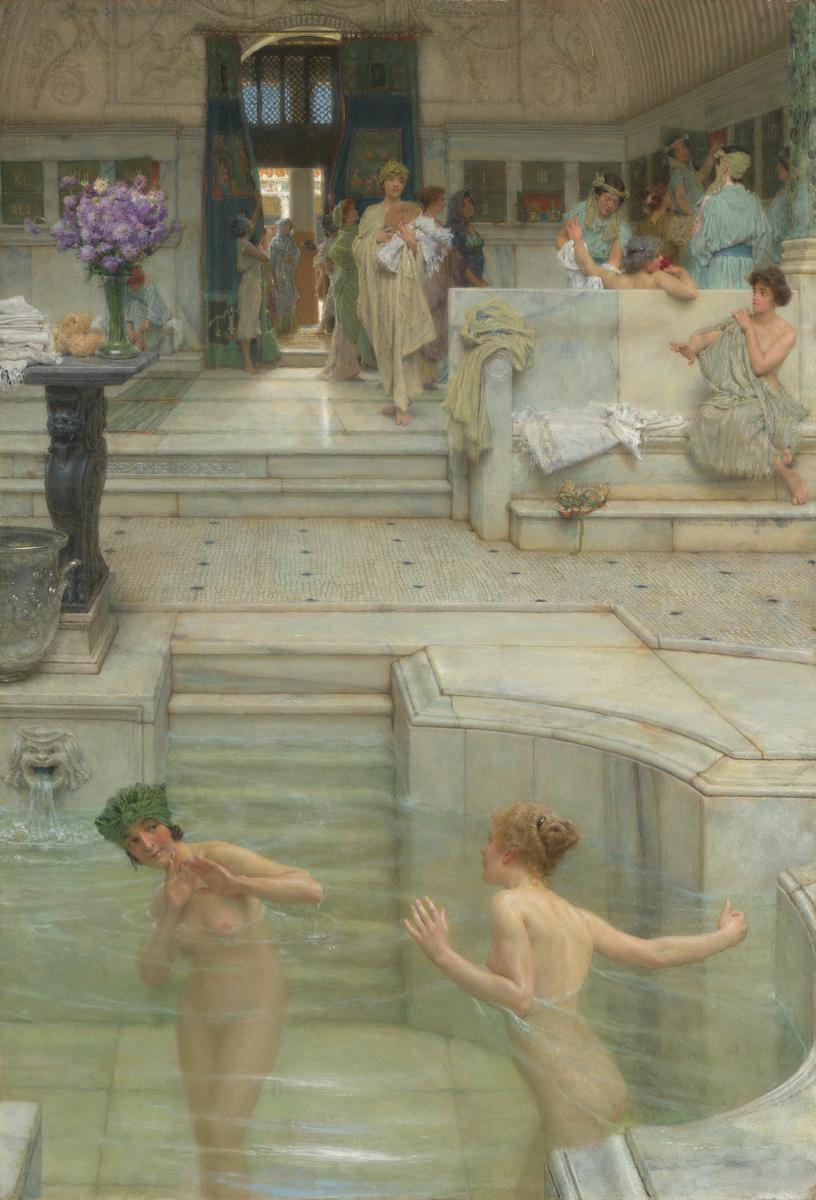
Sir Lawrence Alma-Tadema, A Favourite Custom 1909
This scene is set in the baths at Pompeii. In the foreground one woman playfully splashes another bathing in the ‘frigidarium’, a cold bath. The artist based this work on photographs of the ruins of the Stabian baths, revealed by archaeologists in 1824. He has made them more luxurious by adding a marble floor and walls which would more usually have been found in larger imperial baths. This small work attracted enormous success when it was exhibited and bought immediately for the nation.
Gallery label, February 2016
28/30
artworks in 1815–1905
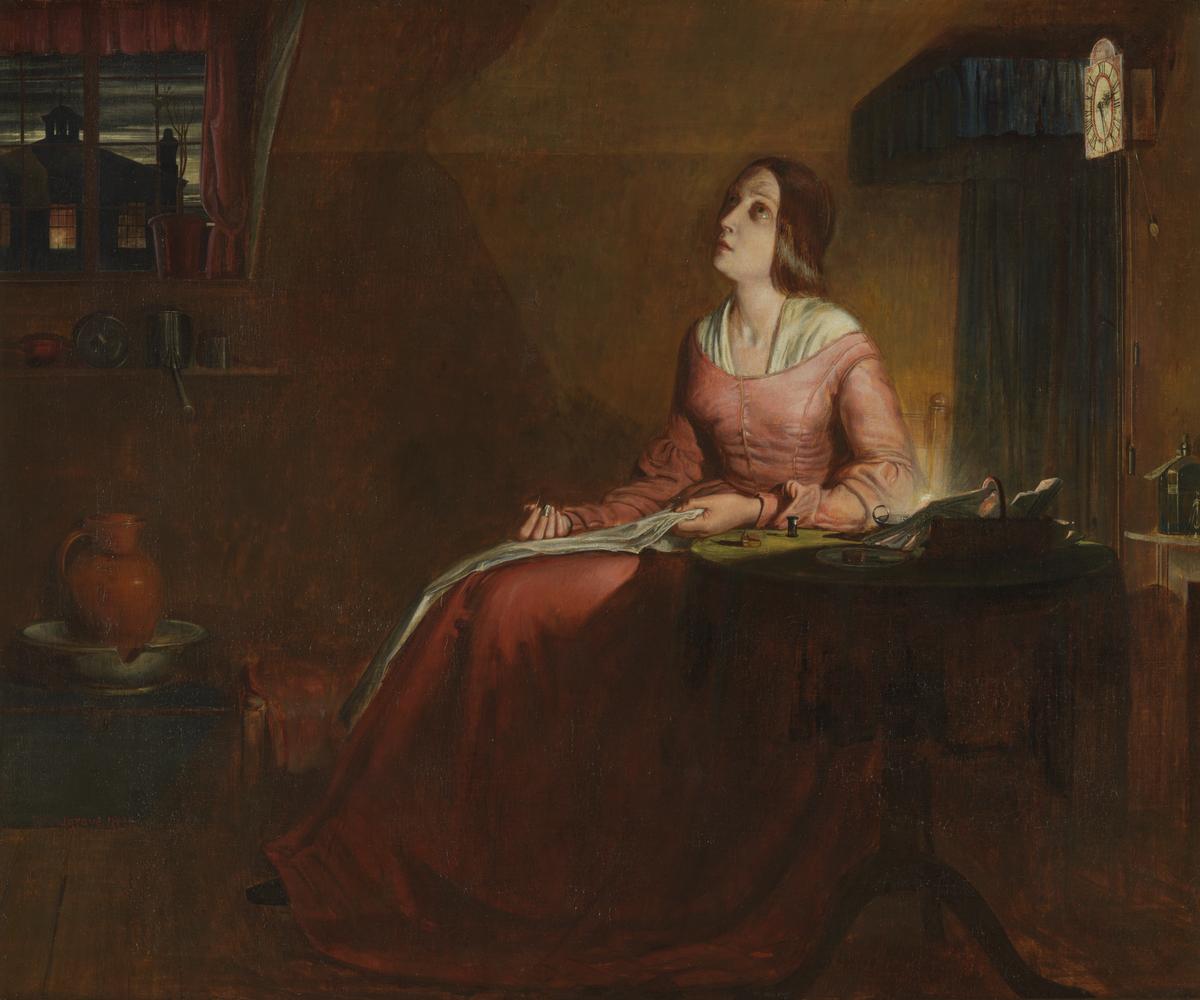
Richard Redgrave, The Sempstress 1846
This painting is the only known version of the lost original which was exhibited at the Royal Academy in 1844 accompanied with lines from Thomas Hood’s popular poem The Song of the Shirt: ‘Oh! men with sisters dear/Oh! men with mothers and wives,/ It is not linen you’re wearing out,/But human creatures’ lives’. The success of the image was largely due to Redgrave’s presentation of the sempstress as a victim in need of salvation. The woman’s pleading expression and posture evoke standard representations of the penitent Magdalene in Old Master painting.
Gallery label, November 2016
29/30
artworks in 1815–1905
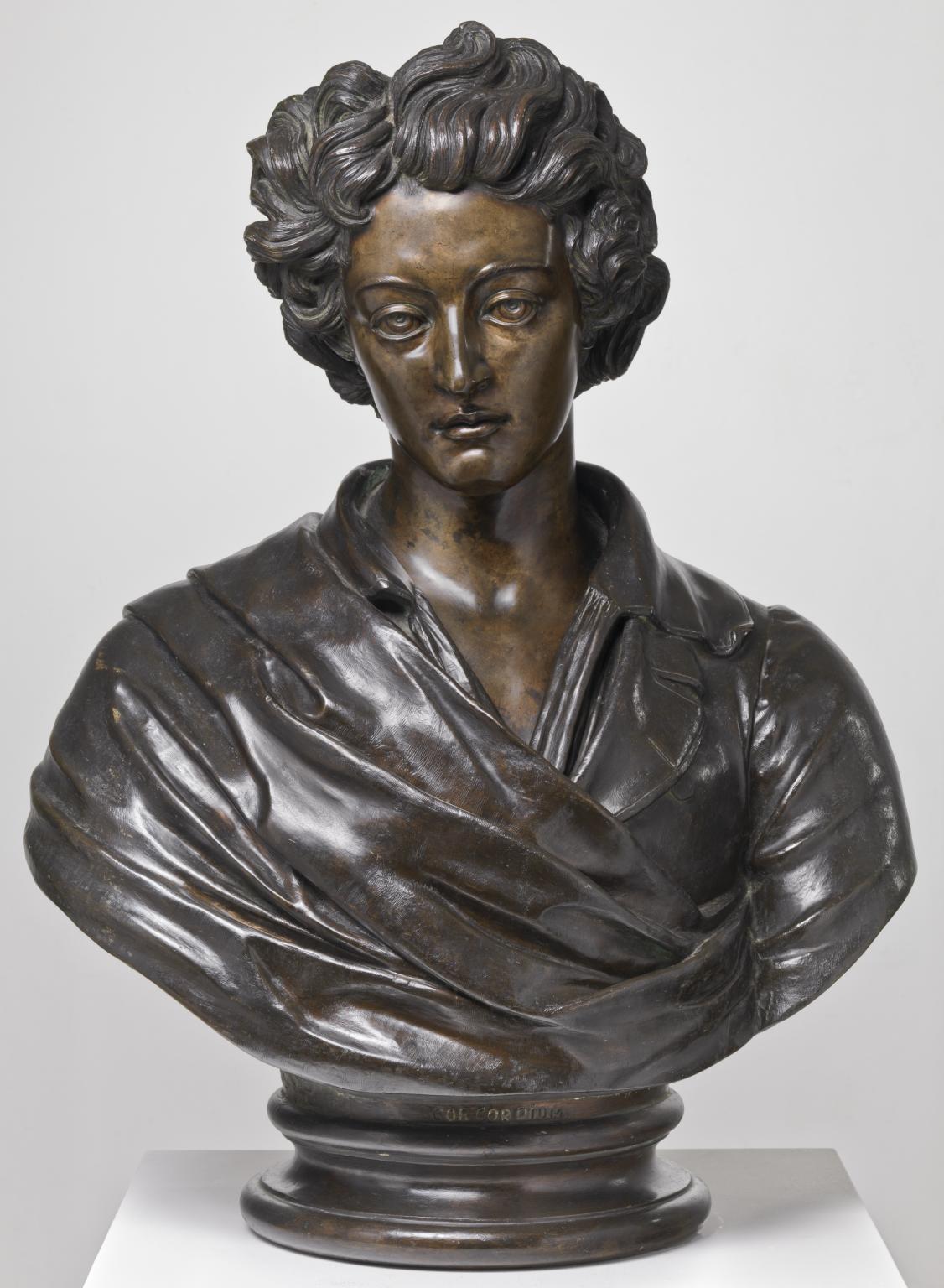
Amelia Robertson Hill, Percy Bysshe Shelley 1882
Hill came from the artistic Paton family and was herself a prominent Scottish sculptor, contributing three figures to the Scott Monument in Edinburgh. There is no reliable likeness of Percy Bysshe Shelley as an adult, and Hill’s fascination for the Romantic poet translated into this monumental idealised bust. A prized possession, she kept it until she died, prominently displayed in the large vestibule of her studio home.
Gallery label, November 2016
30/30
artworks in 1815–1905
Art in this room


























Sorry, no image available



You've viewed 6/30 artworks
You've viewed 30/30 artworks
We recommend
-
Audio Description: Carnation, Lily, Lily, Rose
Listen to and watch an in-depth visual description of this artwork by artist John Singer Sargent
-
How John Singer Sargent painted Carnation, Lily, Lily, Rose
Go behind-the-scenes in our conservation studio to discover the artist's technique
-
John Singer Sargent's Carnation, Lily, Lily, Rose 1885–6
Elaine Kilmurray
The most ambitious plein-air picture the American artist ever painted was far more complicated than its loose style might suggest

